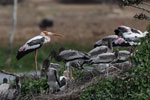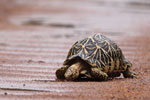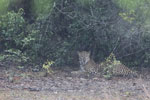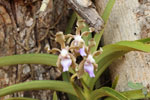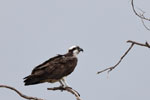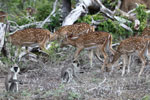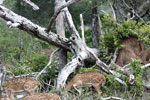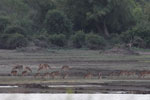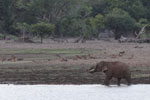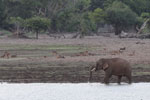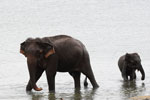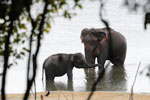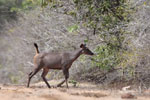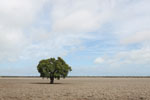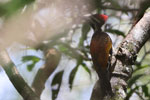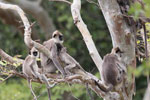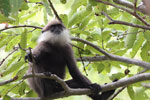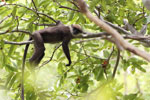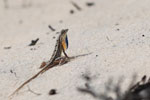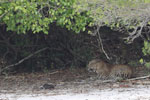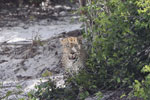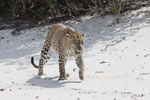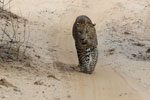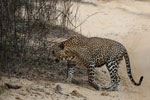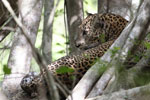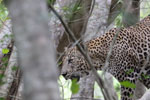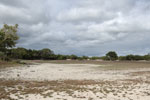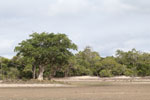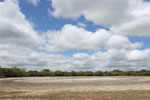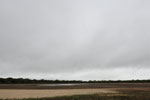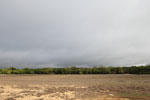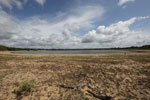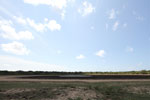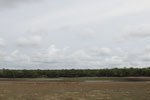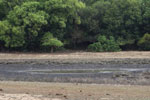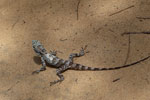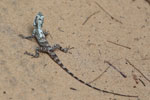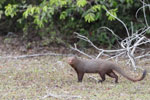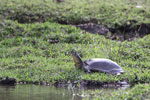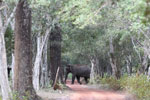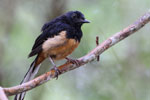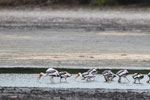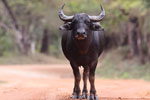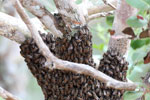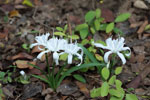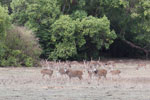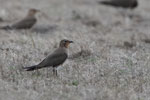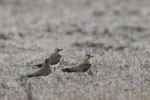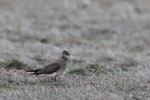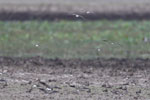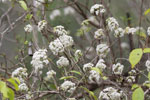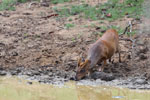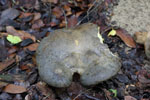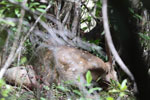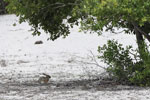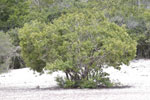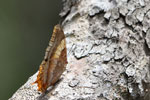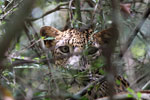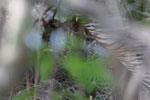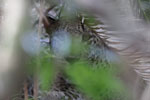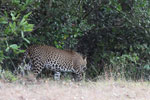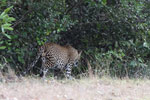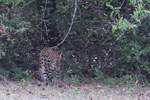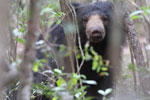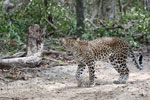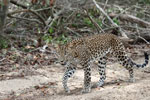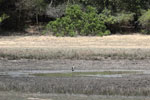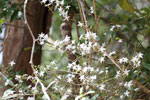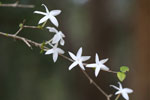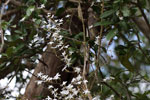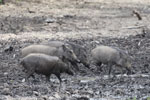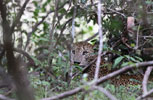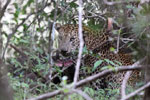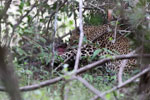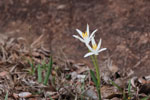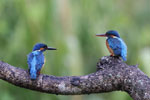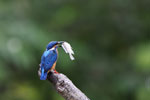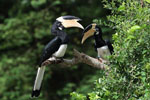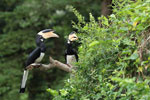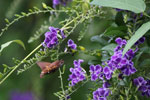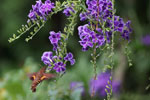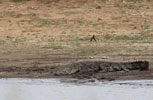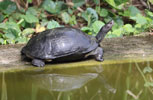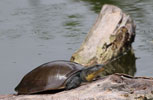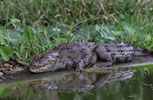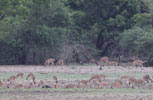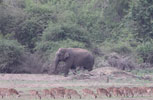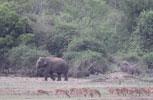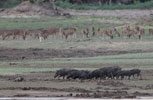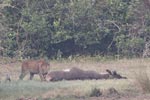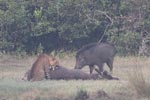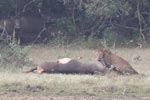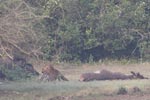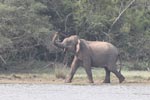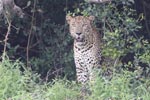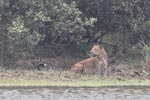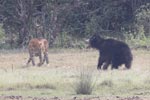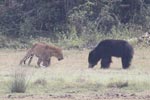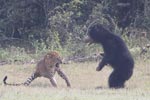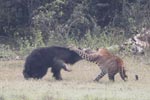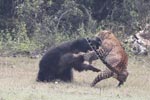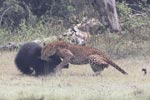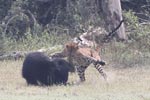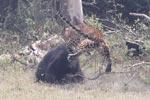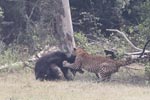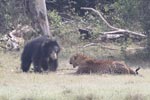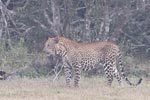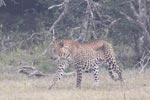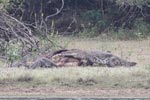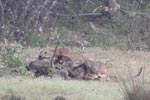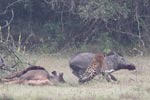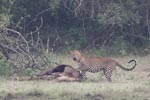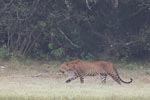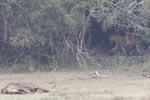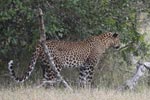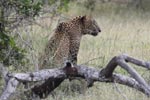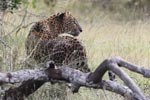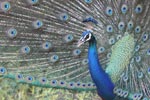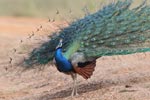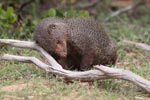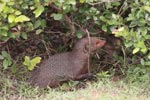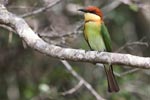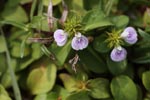
NOTES ON FIELD TRIPS TO WILPATTU NATIONAL PARK
- Wilpattu National Park 30th September to 7th October 2023
I planned to spend the last few days of my annual leave at Wilpattu. Having left Colombo around 6.30am reached our house in Wilpattu by 10.30am. The area had received a few showers but the heavy monsoon rains have not begun as yet.
12.05pm one Indian Buffalo and 7 Mugger Crocodiles at the Hunuwilagama Tank.
12.51pm entered the park. There was intermittent rain. The park is yet to receive the heavy rains which are expected around this time of the year. There was no increase in the water levels of the Hunuwilagama tank or any of the water bodies inside the park.
12.59pm 4 Spotted Deer at Ranawara Pitiya.
1.01pm one Buffalo at Percy Bendi Wewa.
1.03pm 2 Spotted Deer between Percy Bendi Wewa and Thammanna Wala.
1.10pm a Barking Deer and 2 Spotted Deer at Thammanna Wala.
1.20pm a troop of Purple-faced Leaf Monkey between Thammanna Wala and Maha Wewa. This is the least observed monkey species in the park.
1.58pm a Forest Wagtail on the road from Maradanmaduwa to Maha Wewa.
2.04pm I drove down to the furthest end of the bund at Maha Wewa and counted 30 Spotted Deer in the company of 8 Buffalo.
2.09pm a herd of 94 Buffalo close to the Maha Wewa bungalow.
2.17pm the chicks in the nesting colony of Painted Storks at Maha Wewa are now close to leaving the nests. I observed and photographed one pair building a new in June 2023 and followed the progress and the growth of the chicks during each of my visits. The chosen parent birds successfully raised two chicks.
2.26pm 29 Spotted Deer at Maha Wewa.
2.28pm 29 Spotted Deer accompanied by a troop of Grey Langur at Maha Wewa.
2.33pm 86 Spotted Deer, 5 Buffalo and 7 large Mugger Crocodiles at Maha Wewa.
2.35pm an Indian Grey Mongoose at Maha Wewa.
3.35pm the intermittent spells of rains have formed small pools of water on the roads. A Star Tortoise was having a drink of fresh rainwater after almost 4 months dry weather. These tortoises have a remarkable ability to survive the dry months without drinking any water. In the early 70s I have kept these tortoises as pets in our garden in Colombo. On one occasion one went missing for almost one year until it was found hiding in a pile of soft earth and leaf litter in the garden. To my great surprise it was alive and well. They are native to the dry zone and usually bury themselves in leaf litter to keep cool during the dry season and move out of their hiding places with the first rains to forage and lay eggs.
3.40pm 32 Spotted Deer at Maradanmaduwa.
3.42pm another Star Tortoise at Maradanmaduwa.
4.18pm one leopard at Kumbuk Wila pitiya. N 08.42109, E 080.01005
It was a young male and was lying at the edge of the forest across the open glade. I managed to get a few images despite the heavy drizzle. Within a few minutes the cat moved in to the forest. Upon examining its spot pattern, I noted that this is Kumbuk Wila Male 1 (KWMC 1), one of the two male cubs of the famed female Kumbuk Wila Female 2 (KWFC 2) popularly referred to as “Cleopatra” by the safari jeep drivers.
4.22pm 42 Spotted Deer at Kumbuk Wila pitiya.
4.39pm 8 Spotted Deer at Borupan Wila.
4.55pm 9 more Spotted Deer at Borupan Pitiya.
4.58pm 4 Spotted Deer between Borupan junction and Walas Wala.
5.31pm a young male Buffalo at the glade between Divulgas Mandiya and Andaragollawa junction.
6.00pm left the park.
6.15pm 89 Spotted Deer at Hunuwilagama Tank.
Mammals and Reptiles observed during the day.
Mammals - Leopard 1, Indian Buffalo 112, Spotted Deer 374, Barking Deer 1, Toque Monkey, Grey Langer, Indian Grey Mongoose 1, Purple-faced Leaf Monkey, Giant Squirrel, Indian Palm Squirrel.
Reptiles – Mugger Crocodile 14, Black Turtle 5, Star Tortoise 2, Land Monitor, Common Garden Lizard.1st October 2023
6.04am a sounder of 21 Wild Boar feeding at Hunuwilagama Tank.
6.56am entered the park.
7.13am a Mugger Crocodile at Thammanna Wala.
7.16am 3 Spotted Deer on the road from Thammanna Wala to Maha Wewa.
8.19am 20 Spotted Deer at Maradanmaduwa.
9.24am 36 Spotted Deer at Maha Wewa.
9.29am 27 Spotted Deer at Maha Wewa
9.31am 35 Spotted Deer and 7 Buffalo at Maha Wewa.
9.32am 17 more Spotted Deer at Mahah Wewa.
9.33am 27 Buffalo 7 Mugger Crocodiles and 17 Spotted Deer at the furthest end of the bund at Maha Wewa.
10.33am Grey Orchid Vanda tessellata in bloom at Marardanmaduwa.
10.34am 19 Spotted Deer at Maradanmaduwa.
10.35am 5 Spotted Deer between Maradanmaduwa and Thambioluwa.
11.00am a troop of Grey Langur and 5 Spotted Deer on Kokkare Villu upper road.
11.13am an Osprey at Nelum Wila. It has now become a regularly seen species in Wilpattu with some individuals remaining even during the non-migrant season.
11.32am a herd of 12 Buffalo at Kokkare Villu.
11.36am a trop of Grey Langur on Kokkare Villu upper road.
11.56am 6 Spotted Deer at Kudapatessa.
12.40pm 17 Spotted Deer at Nelum Wila.
2.49pm 18 Spotted Deer at Demata Wila.
2.50pm an adult male Wild Boar at Demata Wila.
3.04pm a male Low-land Kangaroo Lizard between Demata Wila and Lunu Wewa.
3.08pm 12 Spotted Deer at Thimbiri Wila.
3.15pm 5 Spotted Deer on Lunu Wewa upper road.
3.33pm two Barking Deer between Humbas Wala and Ibba Wala.
3.42pm 62 Spotted Deer feeding in the company of a troop of Grey Langurs at the “Kukul Katu Pitiya” in Maradanmaduwa. I have often seen these deer moving through the jungle following troops of Grey Langurs. This is a symbiotic relationship that benefits both species. While the troop feeds, the monkeys will always have one member that will act as a ‘look out’ that will constantly watch out for predators from the top and will give out immediate alarm call at the first sign of a predator. The ever-vigilant deer will make its alarm calls if any danger is detected from the ground. Thus, the association results in both species achieving a greater level of security as both these species are hunted by leopards and pythons. The deer, while enjoying greater protection, have a further benefit of being able to relish the tender shoots and fruits constantly dropped by the monkeys as they feed.4.18pm 2 Buffalo at Ranawara Pitiya.
4.25pm left the park.
5.35pm 57 Spotted Deer feeding on the lake shore across Hunuwilagama tank.
5.45pm A tusker with a single tusk walked up to the edge of the water and drank at Hunuwilagama tank.
Mammals and Reptiles observed during the day.
Mammals – Elephant 1, Indian Buffalo 48, Sambhur, Spotted Deer 242, Wild Boar 22, Barking Deer 2, Toque Monkey, Grey Langer, Giant Squirrel, Indian Palm Squirrel.
Reptiles – Mugger Crocodile 15, Black Turtle 7, Land Monitor, Common Garden Lizard, Low-land Kangaroo Lizard, Devaka’s Fan-throat Lizard, Green Garden Lizard.
2nd October 2023
6.05am entered the park.
45 Spotted Deer at the park entrance.
6.10am 2 Spotted Deer between park entrance and Ranawara Pitiya.
6.36am 36 Spotted Deer at Maradanmaduwa.
6.53am a Ruddy Mongoose at Walas Wala
6.55am a Barking Deer at Borupan Junction.
6.58am a Ruddy Mongoose at Kumbuk Wila sand patch.
7.00am 29 Spotted Deer at Kumbuk Wila pitiya.
7.03am 6 Spotted Deer on Kumbuk Wila upper road.
7.04am 8 Spotted Deer on Kokare Villu upper road.
7.12am two Elephants, a mother and a calf at Kokkare Villu. The calf is a Tusker.
7.40am 10 Spotted Deer at Kumutu Villu, which has now become a small puddle of water.
7.45am 7 Spotted Deer between Kumutu and Kanjuran Villu.
7.57am 8 Spotted Deer at Kaali Villu.
8.13am 9 Buffalo and 5 Spotted Deer at Mara Wila.
8.23am 5 Spotted Deer at Avathara Motte.
8.26am 26 Spotted Deer at Paya Motte. They were making frantic alarm calls for a leopard that moved into the forest as I drove in to the villu. I was quite displeased that the leopard moved in before I was able get any images as I had never photographed a leopard at this location.
9.27am a Sambhur on the Mannar road close to Maila Villu.
9.30am Maila Villu has completely dried up. The green foliage of the old Madan tree in the brown dry vastness of the villu created an attractive image.
10.10am 6 Mugger Crocodiles at Kaali Villu.
10.12am 12 Spotted Deer on Kaali Villu upper road.
10.41am a Black-rumped Flameback on Kuruttupandi Upper Road. The reddish orange upper parts and extensive white facial markings are characteristic of one of the four colour forms this species.
10.46am 21 Spotted Deer on Kokkare Villu upper road.
10.47am 13 Buffalo at Kokare Villu.
11.06am 15 Spotted Deer on Panikkar Villu upper road.
11.38am 4 Spotted Deer between Panikkar Villu and Kombansanchaipooval.
11.39am a troop of Grey Langur between Panikkar Villu and Kombansanchaipooval.
11.42am 5 more Spotted Deer at Kombansanchaipooval sand patch.
11.45am 31 Spotted Deer at Tala Wila
11.51am 3 Spotted Deer between Tala Wila and Kombansanchipooval.
12.20pm 8 Spotted Deer feeding close to a troop of Grey Langurs on a tree at Uththamadaru Bridge. The monkeys were engaged in grooming, an activity which creates a greater bond between members of the troop.
12.40pm a troop of dry zone Purple-faced Leaf Monkey at Uththamadaru Bridge. This is one location in the park where this species is regularly seen. There were 8 members in the troop.
1.22pm a Barking Deer at Kombansanchaipooval.
1.27pm a sounder of three Wild Boar on Panikkar Villu upper road.
1.41pm 7 Mugger Crocodiles at Nelum Wila.
2.06pm 4 Spotted Deer at Kokkare Villu.
2.08pm 4 Spotted Deer and one adult male Wild Boar at Kokkare Villu.
2.27pm 36 Spotted Deer at Manik Wila.
2.55pm a male Devaka’s Fan-throat Lizard photographed at the Mana Wila sand patch.
3.13pm 6 Spotted Deer at Manikrala Uraniya.
3.27pm 12 Spotted Deer and two Buffalo at Demata Wila.
3.36pm 14 Spotted Deer at Kumbuk Wila pitiya.
3.39pm 2 Ruddy Mongoose at Kumbuk Wila sand patch.
4.34pm 7 Spotted Deer down Ikirigollawa Road.
5.02pm a troop of Grey Langur between Thammanna Wala and Kukulkatuwa junction.
5.07pm one leopard on Kukulkatuwa road. It was an adult male and was lying on the road. Unfortunately, the big cat ran in to the forest the moment I brought the vehicle to a halt. Thus, I had no opportunity of capturing any images
5.24pm one bull Elephant between Kukulkatuwa junction and Thammanna Wala.
5.57pm left the park
6.05pm one elephant and 68 Spotted Deer at the Hunuwilagama Tank.
Mammals and Reptiles observed during the day.
Mammals – Elephant 4, Leopard 2, Indian Buffalo 24, Sambhur 1, Spotted Deer 443, Wild Boar 4, Barking Deer 2, Ruddy Mongoose 4, Black-naped Hare, Toque Monkey, Grey Langer, Purple-faced Leaf Monkey Giant Squirrel, Indian Palm Squirrel.
Reptiles – Mugger Crocodile 13, Black Turtle 13, Land Monitor, Common Garden Lizard, Low-land Kangaroo Lizard, Devaka’s Fan-throat Lizard.3rd October 2023
6.05am entered the park.
6.06am a sounder of 8 Wild Boar about 100 meters from the park entrance.
6.19am a female leopard ran across the road and disappeared in to the jungle between Paaluwilandawa junction and Thammanna Wala. There was no opportunity to get any images.
6.29am 6 Spotted Deer on Kukul Katuwa Road.
8.06am a Buffalo at Thammanna Wala pitiya.
8.10am a Wild Boar at Palukola wala.
8.45am 28 Spotted Deer at Maradanmaduwa.
9.07am 12 Kokkare Villu upper road.
9.20am one Leopard at Kuruttupandi Villu. N 08.43542, E 079.98268
The adult male leopard was sleeping under the shade of a Madan tree. Within about few minutes a Wild Boar was seen in the distance and the leopard raised its head and was alerted. Though the leopard observed the wild boar for some time he did not make any attempt to attack. Once the swine moved away the cat started to lick its paws, yawned, and walked in the direction of the road. He walked for a short distance on the road and moved into the forest in the direction of the upper road.
I drove on to the upper road and spotted the leopard on a Banyan Tree. Around 10.16am with the arrival of a few more vehicles the leopard climbed down from the tree and disappeared into the forest. This is Nelum Wila Male 5 (NWMC 5) on my site. He is currently the dominant male in the core area of the park.
10.39am a herd of 11 Buffalo at Kudapatessa.
10.55am 7 Spotted Deer at Nelum Wila.
During this trip I photographed many water bodies which have been reduced to small pools and some completely devoid of water. Hunuwilagama tank at the park entrance, Percy Bendi Wewa, Nelum Wila and Kaali Villu held a fair volume of water.
Eriyakkulampooval
Thimbiri Wila
Mahapatessa
Demata Wila
Kaali Villu
Mara Wila
Tala Wila
Kumutu Wila
Heavy dark clouds gathered over the park and the intermittent short spells of showers indicated that the monsoon rains should start soon.
12.45pm I observed a small reptile falling from the canopy ahead of the vehicle on Borupan Wila upper road. It was a Painted-lip Lizard Calotes ceylonensis. These arboreal lizards are never found on the ground and usually occupy the trunks and the upper branched of trees. Males often fall to the ground during territorial fights and stay motionless for a few minutes to recover from the shock. I have seen this happening to the large Bark Geckos and these lizards on a few occasions in the jungles. The reptile will not run away even if you get within touching distance. I drove along side and despite the tire of the vehicle being only a few inches the lizard stayed motionless but the orange colour of its head and nape changed to match the colour of the sandy soil. This indicated that the change in skin colour to match the colour of the surface they are on is not a conscious decision of the lizard but more of an instinctive reaction. I managed to a get a few images before he recovered and ran towards the nearby trees.
2.24pm a Ruddy Mongoose at Maradanmaduwa.
3.02pm 9 Spotted Deer at Eriyakkulampooval.
3.10pm 8 Spotted Deer between Eriyakkulampooval and Manikrala Uraniya.
3.21pm a Flapshell Turtle and a Hardshell Terrapin at Manikrala Uraniya.
4.30pm an Elephant stood at the edge of the road for almost 20 minutes before deciding to cross the road and walk towards the Maradanmaduwa tank. These bull elephants regularly seen in the main villu areas of the park are usually quite calm and pose no danger to the vehicles. However, during the last decade there have been a few vicious attacks on vehicles in the park. Thus, it is always wise to keep your distance when observing elephants and never approach them too close.
5.13pm a Black-naped Hare at Divul Pitiya.
Mammals and Reptiles observed during the day.
Mammals – Elephant 1, Leopard 1, Indian Buffalo 12, Sambhur, Spotted Deer 70, Wild Boar 9, Ruddy Mongoose 1, Black-naped Hare 1, Toque Monkey, Grey Langer, Giant Squirrel, Indian Palm Squirrel.
Reptiles – Mugger Crocodile 8, Flapshell Turtle 1, Black Turtle 9, Star Tortoise 1, Land Monitor, Common Garden Lizard, Low-land Kangaroo Lizard, Devaka’s Fan-throat Lizard, Green Garden Lizard, Painted-lip Lizard.4th October 2023
6.03am entered the park.
56 Spotted Deer at the park entrance.
6.30am 15 Spotted Deer at Maradanmaduwa.
6.36am a Buffalo and 4 Spotted Deer at Thambioluwa.
6.39am a herd of 18 Spotted Deer antlers between Thambioluwa and Ibba Wala.
6.41am a Barking Deer at Ibba Wala.
6.49am a Sambhur between Walas Wala and Borupan junction.
6.59am a Barking Deer at Kokkare Villu upper road.
7.04am 18 Spotted Deer at Nelum Wila pitiya.
7.18am 5 Spotted Deer on Kokkare Villu upper road.
7.25am 4 Spotted Deer antlers and one female between Kuruttupandi vullu and Manik Wila.
7.41am 16 Spotted Deer at Kumutu Villu.
7.45am an adult female Sambhur ran across the road between Manik Wila and Illanda Motte.
8.26am I listened to a beautiful vocalization of a White-rumped Shama at Mahapatessa. The young bird hopped on to an exposed branch when I started mimicking its call permitting me to get a few good images.
8.34am a group of Painted Storks was engaged in communal fishing at Borupan Wila. When water levels recede, these birds employ an effective way of capturing the fish trapped in such pools. They will form into a group and start walking with their half-opened beaks in the water from one end of the pool systematically driving the fish towards the shallow one end of the pool where the fish are easily caught. Sometimes other species such as Cormorants and Openbills also join them. After such a “drive” they will move to dry ground and stay for some time before resuming the same activity again.
9.50am a young male leopard in the large glade between Thammanna Wala and Kukulkatuwa junction. N 08.35515, E 080.12266
It was lying down behind a termite hill and the view was obstructed by small bushes and dried twigs ect. Few vehicles had parked at spots where the cat could be seen through the foliage at an angle. The jeep drivers kindly offered to move their vehicles for me to get a few images, but I declined and decided to take my chances by parking at a spot facing the termite hill where the leopard could not be seen. These young cats are quite restless, and it is my experience that it would only be a matter of time before he will stand up to stretch and look over the termite hill. An hour passed and as I was beginning to doubt my judgment he stood up, stretched, and sat on his hunches permitting me to get a few clear images adequate to identify the spot pattern. After some time, he stalked and charged a Land Monitor but was not successful. There after he moved further into the forest and slept on another earth mound. Around 12.30pm the young male walked into the forest. Upon examining its spot pattern, I noted that this is the young male I have listed as Maha Wewa Road Leopard 7 on my site under Leopards of Wilpattu – Guest section. I was thrilled as this is a new leopard for me and I named it Thammanna Wala Male 2 with the code THWMC 2 for the purpose of my study.
PHOTO 43 - 46
1.37pm a male Indian Buffalo bull caused a “roadblock” and refused to move off the road between “Sohon Pitiya” pond and “Gal Wanguwa”. He was on the road for about 10 minutes before walking into the forest. These animals have an unusual temperament that can turn into aggression instantly. They appear quite docile but if you’re on foot they may charge you or decide to run away from you upon coming ion to view. If they get to you their formidable horns can cause serious injurious and even death. A Buffalo will go on its knees to attack a fallen victim on the ground. On a few occasions in the dry zone forests and once in the Knuckles Forest reserve I had been charged by buffaloes while walking and had to leave my camera equipment and run for my life.
1.43pm 3 Spotted Deer between Maradanmaduwa and Thambioluwa.
1.55pm a Ruddy Mongoose at Walas Wala.
2.02pm a colony of Indian Honeybees Apis cerana floria had gathered on a small tree by the side of the road at Kumbuk Wila sand patch. According to the latest research Sri Lanka is home to 149 species of bees. The commonly known honeybees of these include the current species, referred to as “me massa” in Sinhala with their hive being referred to as the “me wadaya”, the Red Dwarf Honeybee Apis florea referred to as “dandu messa”, with their hive being referred to in Sinhala as a “danduwellawa” and the tiny Indian Stingless Bee referred to as “Kanewe messa” with their hive being referred to in Sinhala as the “Kaneiyyawa”. The last of the commonly known honeybees is the much-feared Giant Honeybee popularly known for their vicious attacks as the “Bambara”. Usually, Indian honeybees are never found in the open like this as their hives are built in concealed places such as tree holes or a crevice in rocks ect. This is a honeybee colony in transit. A typical colony of Indian honeybees contain three types of adult bees. Female Worker bees who attend to the work of the beehive including the collection of nectar, building, and repairing the hive, defending the colony, feeding the larva. Mature male bees who do not possess stingers and do not go out to collect nectar and referred to as drones. The only responsibility of a drone is to mate and fertilize the queen. The third category is the queen bee whose sole responsibility is to produce offspring. The worker bees build special large cells referred to as “queen cells” and feed the larva placed in them with a nutrient rich special substance secreted from their bodies referred to as “royal jelly”. Such larva will grow to become new queens. When a new queen is mature enough she will replace the existing queen if she is too old or will leave the colony accompanied by a group of bees to form a new colony. While they are in search of a new location to establish their new colony they often rest for a few hours before resuming their search. This was such a colony. They were gone by evening.
2.04pm Ceylon Spider Lily in bloom between Kumbuk Wila sand patch and Borupan junction.
2.10pm a herd of 4 Spotted Deer feeding on Madan berries fallen on the ground on Kokkare Villu upper road.
2.15pm 26 Spotted Deer at Nelum Wila pitiya.
2.41pm a Barking Deer on Panikkar Villu upper road.
2.43pm 22 Spotted Deer at Panikkar Villu.
2.46pm 6 Spotted Deer at Kombansanchaipooval
3.07pm 66 Spotted Deer at Tala Wila.
3.09pm a flock of about 250 Oriental Pratincoles at Tala Wila. This is my second sighting of this species in the park. The first being at the lake shore at Hunuwilagama tank on the 23rd of October 2021 but I was not able to get any images as they were too far for photography.
3.56pm a short burst of very heavy rain around Panikkar Villu.
4.48pm a Sambhur at Thambioluwa.
5.12pm a Star Tortoise on Kukulkatuwa road.
5.56pm left the park.
Mammals and Reptiles observed during the day.
Mammals - Leopard 1, Indian Buffalo 2, Sambhur 3, Spotted Deer 264, Wild Boar 1, Barking Deer 3, Ruddy Mongoose 1, Black-naped Hare 1, Toque Monkey, Grey Langer, Giant Squirrel, Indian Palm Squirrel.
Reptiles – Mugger Crocodile 4, Black Turtle 9, Star Tortoise 2, Land Monitor, Common Garden Lizard, Low-land Kangaroo Lizard, Devaka’s Fan-throat Lizard.5th October 2023
6.00am a sounder of 22 Wild Boar and 15 Mugger Crocodiles at Hunuwilagama Tank.
6.30am entered the park.
A tusker with a single tusk on its left about 100 meters from the park entrance. The elephant had been on the road but had moved into the forest and could be seen through the foliage.
6.47am A Chamror Tree Ehretia laevis with clusters of white flowers at the park entrance. I was not able to identify the species. Thus, I sought the support of Dr. Jacob de Vlas, the author of the three volumes on the illustrated Field guide to the Wildflowers of Sri Lanka, who kindly pointed out the correct identification.
7.21am 18 Spotted Deer between the park entrance and Ranawara Pitiya.
7.24am one Buffalo at Percy Bendi Wewa.
7.25 am a male Barking Deer between Percy Bnedi Wewa and Paaluwilandawa junction.
7.35 am a Barking Deer drank water at Thammanna Wala.
8.28 am 17 Spotted Deer at Maradanmaduwa.
8.30am a bachelor party of 3 Spotted Deer stags at Thambioluwa.
8.51 am 17 Spotted Deer on Kokkare Villu upper road.
8.54am a large troop of Grey Langur and Toque Monkeys in the company of 8 Spotted Deer on Kokkare Villu upper road. The young Langurs were engaged in chasing each other playfully and climbing up and down the trees. Even though the two monkey troops were in close proximity with each other the Toque monkeys did not join the langurs in their play.
9.02am 21 Spotted Deer at Nelum Wila pitiya.
9.11am the large Painted Slippercap mushrooms of Suillus species at Nelum Wila.
9.46am I arrived at the Spotted Deer kill at Kombansnchaipooval. Other than for the stomach area the carcass was intact which meant that the leopard had made the kill in the early hours of the morning. I’m thankful to safari jeep driver Dinesh for informing me of this kill. The carcass was lying about 25 feet from the road but was covered with foliage and could only be seen through a small opening. The leopard was lying under a “Madu” tree about 10 feet from the kill and was completely concealed from view. It was quite shy and would move into the thicket the moment a vehicle comes close to the kill. Since it was a weekday there were only a handful of vehicles in the park. Dinesh told me that the leopard was on the road when he arrived and moved in upon the vehicle coming into view. Since there were no signs of the leopard visiting the kill, he had parked about 50 meters from the kill and waited for about 15 minutes before driving to the location where his guests were able to see a glimpse of the leopard before he moved back into the thicket. I waited until 12.00noon with no luck and was determined to photograph the leopard. Thus, decided to leave enabling the leopard to feed in peace. A leopard would always leave its kill and walk towards water after feeding. Since the only water source nearby was Tala Wila, there was a very good probability of the leopard would rest after feeding and move out of his hiding towards evening to visit Tala Wila.
12.15pm 7 Mugger Crocodiles at Nelum Wila.
12.21pm a female Barking Deer between Kokkare Villu and Kuruttupandi Villu.
12.24pm a Black-naped Hare under the shade of a bush at Kuruttupandi Villu. It’s not usual for this animal to be out in the open during mid-day. Perhaps the small mammal would have been disturbed by a predator from its place of hiding.
12.46pm a female Tawny Raja between Kuruttupandi villu and Kokkare Villu. This is an uncommon species of butterfly, and the female is less common than the male. They are extremely fast flying butterflies. Thus, I was quite pleased to have spotted this female that was settled on a branch of a tree by the side of the road. Thankfully she did not flyoff until I was able to get a few images.
1.02am one leopard between Nelum Wila and Panikkar Villu. N 08.40024, E 079.96857
On my way back to Kombansanchipooval I was pleased to have met with a leopard between Nelum Wila and Panikkar Villu. It was a young male leopard and moved into the forest the moment I saw him. After having waited for some time, I drove up to the point where he entered the forest and was thrilled to have spotted him seated among the foliage. Only its head was visible, and I managed get one image before he moved into the forest. Later upon checking its spot pattern I was pleased to note that this is Panikkar Villu Male 2 PVMC 2 on my site. This is one of the cubs of the second litter of Panikkar Villu Female 2. My first sighting of this leopard was on the 16th of October 2022 with its mother at a Spotted Deer kill at Panikkar Villu bungalow junction. This is my second sighting of this young male.
1.20pm I was back at the Spotted Deer kill and parked at a distance expecting to photograph the leopard when he moved out to walk towards Tala Wila.
4.05pm one leopard at Kombansanchaipooval. N 08.38572, E 079.95053
Since there was no sign of the leopard and as I had to leave by 4.30pm to reach the park entrance by 6.00pm I drove up the point where the kill can be seen and started to scan the location with my binoculars and detected the movement of a white spot and knew it had to be the tip of the tail of the leopard as it flicks the tail to chase off insects. After much effort spotted the leopard in its place of hiding. It was an adult male and was looking in my direction with its head raised. I managed to a get a few images of its partly covered face before he lowered his head again. I was quite pleased and relieved that I managed to get some images to identify the cat. Just then Amith, who is a safari jeep driver from Eluwankulama arrived. I showed him from where the leopard can be seen and moved my vehicle allowing him and his visitors to have a view. Within less than a minute he signaled that the leopard moved. I quickly reversed expecting the leopard to move to the open glade. Amith also followed and after a few very anxious moments we spotted the leopard moving out of the thicket. He walked along the edge of the forest towards Tala Wila. I managed to photograph the cat as he walked but there was no opportunity get any images of its face since he never looked in our direction. There after we saw the leopard moving on to the road that leads to Tala Wila but moved back into the forest again. Since it was 4.30pm I did not have the time to follow the leopard and decided to leave. I was happy as I finally got some images enabling me to identify this elusive leopard. Later upon examining its spot pattern I noted that this is Walas Wala Male 3 (WWMC 3), a leopard that I photographed at Walas Wala on the 27th of July 2018. This leopard was born in October 2016 in a litter of two, close to Walas Wala but its sibling did not survive. He was seen around Walas Wala with its mother up to about mid 2018. Even after leaving its mother, I received images of him from around walas Wala until mid 2019. There after by 2020 he moved towards Nelum Wila. It appears that he has now established his territory around Kombansanchaipooval.
4.33pm 33 Spotted Deer at Panikkar Villu.
4.34pm a sounder of 4 Wild Boar on Panikkar Villu upper road.
5.18pm a Black-naped Hare in the glade beyond the water hole on Maradanmaduwa Maha Wewa road.
5.25pm 2 Spotted Deer at Eda Kohomba Gaha pitiya.
6.00pm left the park.
Mammals and Reptiles observed during the day.
Mammals – Elephant 1, Leopard 1, Indian Buffalo 1, Spotted Deer 95, Wild Boar 26, Barking Deer 1, Black-naped Hare 1, Toque Monkey, Grey Langer, Giant Squirrel, Indian Palm Squirrel.
Reptiles – Mugger Crocodile 22, Flapshell Turtle 1, Black Turtle 8, Star Tortoise 1, Land Monitor, Common Garden Lizard, Low-land Kangaroo Lizard, Devaka’s Fan-throat Lizard, Green Garden Lizard.6th October 2023
6.00am entered the park.
64 Spotted Deer at the park entrance.
6.23am 42 Spotted Deer at Maradanmaduwa
6.24am 15 more Spotted deer at the Kukul Katu pitiya” at Maradanmaduwa.
6.26am one Sloth Bear feeding on Madan berries fallen on the ground at Maradanmaduwa.
6.30am 8 Spotted Deer at Thambioluwa
6.42am 14 Spotted Deer at Kumbuk Wila sand patch.
6.44am a Ruddy Mongoose on Kumbuk Wila upper road.
6.45am 3 more Spotted Deer on Kumbuk Wila upper road.
6.46am 9 Spotted Deer at Madangaha Wala.
7.09am 67 Spotted Deer at Tala Wila.
7.13am 27 Spotted Deer at Tala Wila.
7.25am 16 Spotted Deer at Panikkar Villu.
7.26am 15 more Spotted Deer at Panikkar Villu.
7.40am a Barking Deer at Panikkar junction.
7.52am 6 Mugger Crocodiles at Nelum Wila.
7.54am 17 Spotted Deer and a herd of 11 Buffalo at Nelum Wila pitiya.
8.35am a Barking Deer between Nelum Wila and Panikkar Villu.
8.36am another Barking Deer on Panikkar Villu upper road.
8.40am a Sloth Bear at Kohombansanchaipooval.
The adult male bear ran into the forest upon coming into view, but the curious animal stopped and looked in the direction of the vehicle from a distance before dashing deep into the safety of the forest. Unlike the bears found between the park entrance and Walas Wala who are quite tolerant of safari vehicles, most bears in other parts of the park are not accustomed to safari vehicles and are seldom seen during daytime.
8.42am arrived at the Spotted Deer kill at Maradanmaduwa. The kill had been partly consumed and had been dragged from where it was the previous day. I was not able to spot the leopard in the thicket in its usual hiding place. I decided to park the vehicle about 50 meters from the kill so that I would be able to observe any animal approaching the kill even though the kill was not visible. Observing the behaviour of other animals is an effective way to find out whether a leopard is in the vicinity.
8.58am a Ruddy Mongoose approached the kill suggesting that the leopard was not hiding in the thicket.
10.00am a sounder of 6 Wild Boar with one individual that had a limp arrived and started to feed on the kill. I decided to leave and come back in the evening. It is likely that the leopard had eaten its fill and would visit the kill in the evening.
12.24pm one leopard on Kokkare villu upper road. N 08.42297, E 079.98383
The female leopard was moving on to the road that leads to Kuruttupandi Villu. I reversed the vehicle and switched off the engine. The leopard remained on the road briefly and walked in the direction of Kuruttupandi villu but moved into the forest upon the arrival of another safari vehicle. Upon checking its spot pattern, I was quite pleased to note that this is Kokkare Villu Female 1 (KKVFC 1).
12.50pm Kumutu Villu is reduced to a small pool of water. A lone Lesser Adjutant stork was looking for prey trapped in the pool.
1.15pm 16 Spotted Deer and 16 Buffalo at Kaali Villu.
1.20pm the rare and fragrant Coffee Flower Coffea wightiana in bloom at Kuveni palace in Kaali Villu. This is an endangered species of small tree which is rarely seen in the park. I photographed the flowers of this species for the first time in August 2014 close to Borupan Wila.
1.30pm Mara Wila is also reduced to a small pool.
1.45pm 28 Spotted Deer at Kumutu Villu.
2.37pm 12 Spotted Deer and a sounder of 11 Wild Boar at Manik Wila sand patch.
3.20pm 8 Spotted Deer at Aalam Villu.
3.29pm the sounder of 6 Wild Boar that fed from the leopard’s kill had moved to the dried-up pool of water which had only had some wet mud at the center at Kombansanchaipooval.
3.39pm a troop of Grey Langur at Tala Wila.
4.28pm one leopard at Kombansanchaipooval. N 08.38572, E 079.95053
I was parked a short distance away from the Spotted Deer kill from 3.45pm expecting the leopard to arrive along the road. Around 4.28pm heard growling and knew that the leopard had arrived at the kill from the side of the glade. I allowed the leopard to start feeding for a few minutes and reversed the vehicle to the spot where the kill could be seen. The leopard looked in my direction, permitting me to get a few much clearer images of its face and head than yesterday, and continued to feed. It was Walas Wala Male 3 (WWMC 3), the same leopard photographed yesterday at this kill. As it takes about an hour and half to reach the park entrance from Kombansanchaipooval I had no option by to leave the feeding leopard and leave. However, after two days of effort I finally managed to get a few images of the leopard at its kill.
5.14pm 8 Spotted Deer and two Wild Boar between Thambioluwa and Maradanmaduwa.
5.17pm 16 Spotted Deer just beyond Maradanmaduwa bungalow.
5.24pm Black-naped Hare down Maha Wewa Road.
5.34pm Forest Spider Lily in bloom between Palukola Wala and Divul Pitiya.
5.42pm a Black-naped Hare at the Thammanna Wala glade.
5.47pm a Wild Boar and one Buffalo at Percy Bendi Wewa.
6.00pm left the park.
Mammals and Reptiles observed during the day.
Mammals - Leopard 2, Sloth Bear 2, Indian Buffalo 27, Spotted Deer 385, Wild Boar 19, Barking Deer 3, Ruddy Mongoose 1, Black-naped Hare 1, Toque Monkey, Grey Langer, Giant Squirrel, Indian Palm Squirrel.
Reptiles – Mugger Crocodile 6, Flapshell Turtle 1, Black Turtle 8, Star Tortoise 1, Land Monitor, Common Garden Lizard, Low-land Kangaroo Lizard, Devaka’s Fan-throat Lizard, Green Garden Lizard.7th October 2023
I did not visit the park since I had a few matters to attend to in the house. The usual pair of Common Kingfisher visited the perch I had set up overlooking the garden pond. They keep bobbing their tiny heads while lifting their tail feathers but keep a watchful eye on the movement of fish. At the right moment one would dive causing a splash and emerge with a small fish.
A pair Malabar Pied Hornbills visited the newly created feeding station.
Early morning a Hummingbird Hawkmoth Macroglossum corythus visited the Sky Flower bush Durantha repens. This species produces nectar rich flowers throughout the year and attracts many species of butterflies and moths.
During mid-morning many Mugger Crocodiles were observed sunning at the Hunuwilagama tank.
A Mugger Crocodile, many Black Turtles and a few Flapshell Turtles seen basking in the sun at the garden pond.
Towards evening 135 Spotted Deer, 31 Wild Boar and one Elephant visited the Hunuwilagama tank.
Birds, Butterflies & Flora observed during the field trip
Birds – Lesser Adjutant, Painted Storks, White-necked Stork, Forest Wagtail, Green Leaf Warbler, Osprey, Layard’s Flycatcher, Oriental Pratincoles
Butterflies - Common Jay, Blue Mormon, Pea Blue, Red Spot Duke, Tawny Raja, Common Mime
Wild Orchids – Vanda tessellate, Vanda spathulata
Fruiting Trees - Madang, Ilapaththa
Wildflowers – Coffea wightiana Cofee Flower (E) Kopi Mal (S) Pita Madu (S), Crinum zeylanicum Beautiful Crinum (E) Goda Manel (S), Pancratium biflorum Forest Spider Lily (E) Wal-lunu (S),
Pancratium zeylanicum Ceylon Spider Lily (E) Wal Lunu (S - Wilpattu National Park 9th - 10th September 2023
4.15am 3 Elephants walked down the Hunuwilagama tank bund to drink from the garden pond. They remained in the garden for a bout 15 minutes before walking across the electric fence into the park.
6.50am entered the park.
7.05am a Barking Deer Paaluwilandawa junction and Thammanna Wala.
7.19am another Barking Deer at the “Sohon Pitiya” pond.
7.21am 2 Spotted Deer between “Sohon Pitiya” pond and Maradanmaduwa.
8.45am two leopard cubs at Maradanmaduwa. N 08.37364, E 080.07178
It was a male and a female. They were climbing up and down trees and engaged in chasing each other. After some time with the rise in temperature both lay down on a termite hill to rest. During the dry season Leopards often sleep on termite hills due to the exterior of these being cooler than the rest of the ground. Upon examination of their spot pattern, I was quite pleased to note that these are the two fifth litter cubs of Maradanmaduwa Female 1 (MMFC 1). This is my first sighting of these two cubs. Thus, for the purpose of my study I named them Maradanmaduwa Male 4 (MMMC 4) and Maradanmaduwa Female 4 (MMFC 4).
10.16am 3 Spotted Deer between Maradanmaduwa and Maha Wewa.
10.31am a large Mugger Crocodile sunning on an exposed sand bank at Maha Wewa. The receding water level has resulted in many such islands to be formed. These are used by these reptiles and many species of water birds.
10.32am 27 Water Buffalo at Maha Wewa.
10.33am a flock of 15 Purple Swamphen at Maha Wewa. Even though this is a common resident species in the country, they are seldom seen in such large numbers.
10.35am a troop of 7 Purple-faced Leaf Monkey at Maha Wewa.
10.37am the Painted Storks that nested at Maha Wewa has successfully raised many young. I have observed and kept records of these nesting birds from July this year.
10.38am 8 more Buffalo and 32 Spotted Deer at Maha Wewa.
10.40am 10 more Spotted Deer resting under the shade of a tree. Even at this time of the day the rays of the sun were quite strong.
10.45am a carcass of a Spotted Deer antler was seen at Maha Wewa. This did not look like a leopards kill since the belly area was intact and it was seen on open ground. Usually, a leopard would start feeding the soft organ of its kill through the belly and would drag its kill to cover, unless it is a heavy animal such as an adult Sambhur.
10.50am an Elephant was in the water at Maha Wewa. He was not feeding on water plants but continued to spray water on its body.
10.51am 4 more Buffalo and 55 Spotted Deer at Maha Wewa.
10.54am 5 Spotted Deer between Maha Wewa and Thammanna Wala.
11.28am a Barking Deer between Paaluwilandawa junction and Thammanna Wala.
11.32am a herd of 9 Buffalo between Thambioluwa and Ibba Wala.
12.02pm 3 Spotted Deer at Ibba Wala.
12.42pm 12 Spotted Deer at Nelum Wila Pitiya.
12.43pm 10 Spotted Deer at Nelum Wila.
1.26pm 12 Spotted Deer at Tala Wila.
1.27pm a Barking Deer at Tala Wila.
1.28pm 3 more Spotted Deer at Tala Wila.
2.14pm a Troop of Grey Langur on Kuruttupandi upper road.
2.26pm 5 Spotted Deer at Kumutu Villu.
3.07pm a subadult Sambhur at Mana Wila.
3.16pm 8 Spotted Deer at Mana Wila.
3.20pm a troop of Grey Langur between Illanda Motte and Manikrala Uraniya.
3.30pm 8 Spotted Deer at Manikrala Uraniya.
3.47pm a Black-naped Hare and 41 Spotted Deer at Kumbuk Wila pitiya.
3.54pm one leopard at Borupan Wila. N 08.42706, E 080.02002
It was an adult female leopard, and she was lying at the water’s edge shielded by a shadow of a bush. Later upon examination of its spot pattern I was able to identify her as Kumbuk Wila Female 2 (KWFC 2). This leopardess is popularly referred to as “Cleopatra”.
4.29pm 6 Spotted Deer at Borupan Wila.
4.50pm one elephant at Maradanmaduwa.
4.53pm a Barking Deer at the water hole down Mahah Wewa road.
5.11pm 11 Spotted Deer at Maradanmaduwa.
6.07pm left the park.
6.10pm a herd of 14 elephants and 52 Spotted Deer at Hunuwilagama tank.
Mammals and Reptiles observed during the day.
Mammals – Elephant 19, Leopard 3, Sloth Bear, Indian Buffalo 43, Sambhur 1, Spotted Deer 283, Wild Boar, Barking Deer 5, Golden Jackal, Ruddy Mongoose, Black-naped Hare 1, Toque Monkey, Grey Langer, Indian Grey Mongoose, Purple-faced Leaf Monkey Indian Brown Mongoose, White – spotted Chevrotain, Common Palm Civet, Small Indian Civet, Sri Lanka Golden Striped-backed Palm Civet, Fishing Cat, Rusty Spotted Cat, Jungle Cat, Indian Crested Porcupine, Giant Squirrel, Indian Palm Squirrel.
Reptiles – Mugger Crocodile 6, Black Turtle 7, Star Tortoise 1, Land Monitor, Common Garden Lizard, Low-land Kangaroo Lizard, Devaka’s Fan-throat Lizard, Green Garden Lizard.10th September 2023
2.15am 2 Elephants walked through the garden and climbed on to the Hunuwilagama tank bund.
6.56am entered the park.
7.25am 3 Spotted Deer at Kukulkatuwa junction on the Mahah Wewa road.
7.32am 42 Spotted Der and a Buffalo at Mahah Wewa.
7.34am a herd of 15 Buffalo and 31 Spotted Deer at Maha Wewa.
7.40am 5 Spotted Deer between Maha Wewa and Maradanmaduwa.
7.44am 3 Barking Der at a dried-up water hole between Mahah Wewa and Maradanmaduwa.
7.45am a Black-naped Hare and a Ruddy Mongoose between Maha Wewa and Maradanmaduwa.
7.53am one leopard between Maha Wewa and Maradanmaduwa. It was an adult male and was seated on the road but ran in to the forest as I came into view. I switched off the engine and waited for about 15 minutes, but the leopard did not make any appearance.
8.13am one adult female leopard on Maradanmaduwa Maha Wewa road. N 08.39417, E 080.09879
It was an adult female, and she was walking in the direction of Maradanmaduwa. She was not disturbed by the vehicle and continued her walk for about 50 meters before walking into the forest. I notice that she had an injury on her left leg. But the injury did not seem to have hampered her too much as was walking quite well. Later, upon examination of her spot pattern I noted that this is Maradanmaduwa Female 2 (MMFC 2) who had been seen on this road with her first litter of two cubs. She is popularly referred to as “wisipaha” (twenty-five) by the jeep drivers due to the spot pattern on her forehead resembling the figure twenty-five. My last sighting of this female was on the 4th of February 2018 more than 5 years ago.
8.53am 18 Spotted Deer close to the Maradanmaduwa dormitory.
9.45am 2 Leopards at Maradanmaduwa Kukulkatu pitiya. N 08.37428, E 080.07125
As I arrived one of the cubs climbed a tree and the other remained on a termite hill. Except for about 20 minutes where I drove down to the Maha Wewa Road upon receiving information of a leopard, I spent the whole day observing and photographing these two cubs. Except for about an hour where the male also climbed a tree, he remained sleeping on the termite hill. The female jumped down from the tree and joined the male around 4.15pm. It was the same two cubs Maradanmaduwa Male 4 (MMMC 4) and Maradanmaduwa Female 4 (MMFC 4) that I observed and photographed yesterday morning across the road.
1.28pm one leopard on Maradanmaduwa Maha Wewa road close to the water hole. N 08.38462, E 080.09327
upon receiving information of a leopard on a tree close to the water hole on the Mahah Wewa road I decided to drive down. There were few jeeps that had gathered at the location, and I was told that the leopard climbed down the tree and moved into the forest seconds before my arrival. I drove up a little as I expected the leopard to move across the road. A jeep ahead of me flashed its headlights which is signal to stop as a leopard is moving to the road. I angled the vehicle and stopped. In less than a minute I observed the leopard moving through the jungle towards the road and managed to a get a few images as the cat moved swiftly across the road. It was Maradanmaduwa Female 2 (MMFC 2) that I observed and photographed in the morning about on this road about one kilometer from this location.
5.50pm 2 Buffalo at Divulgas Mandiya.
6.10pm left the park.
6.20pm 2 Elephants drinking at the Hunuwilagama Tank. I also counted 37 Spotted Deer grazing on the exposed tank shore.
Mammals and Reptiles observed during the day.
Mammals – Elephant 2, Leopard 4, Indian Buffalo 16, Spotted Deer 98, Barking Deer 3, Ruddy Mongoose 1, Black-naped Hare 1, Toque Monkey, Grey Langer, Giant Squirrel, Indian Palm Squirrel.
Reptiles – Mugger Crocodile 4, Flapshell, Black Turtle 5, Land Monitor, Common Garden Lizard, Low-land Kangaroo Lizard, Devaka’s Fan-throat Lizard, Green Garden Lizard.
Birds, Butterflies & Flora observed during the field trip.
Birds – Lesser Adjutant, Painted Storks, White-necked Stork, Drongo Cucukoo,
Butterflies - Common Rose, Blue Mormon, Red Spot Duke,
Wild Orchids – Vanda tessalate
Fruiting Trees - Madang (some trees in fruit) - Wilpattu National Park March 2023
The first weekend in March 2023 was a long weekend. I planned to visit Wilpattu National Park as I have done at least once every month since 2012, except when the park was closed due to the pandemic.
The primary purpose was to study the fauna & flora of Wilpattu and specifically, the behaviour of leopards, a species I found fascinating but knew very little about. I had learnt from the late Dr Ravi Samarasinghe and the late Mr Nanda Senanayake, the importance of identifying individual leopards to understand the behaviour of these elusive cats. A leopard can be identified with a clear image since the spot and rosette pattern on the coat of a leopard is unique. Thus, I started to keep records of each leopard observed and photographed in the park. This data was uploaded to a website (www.wilpattu.com) launched to create awareness and highlight the importance of protecting the park. Within a short period, I started receiving requests from individuals wanting to identify the leopards they had photographed at Wilpattu. This helped update records of each leopard and resulted in the study becoming even more comprehensive and the images received were uploaded to a dedicated page created for each contributor. Currently more than one hundred photographers, including many safari jeep drivers and visitors regularly share their leopard images and as of the date of this article, this database comprises 150 leopards of which 99 are captured by me and another 51 by photographers who contribute to the study. Analysing the collected information also allows me to better understand many intriguing aspects of leopard behaviour.
Considering that 73% of Wilpattu is covered with dense forest with a limited road network, the opportunity of studying leopard behaviour is often a challenge. Most sightings are limited to a single leopard walking or lying down on a road, or in an open area of a villu. Thus, the information of a sambhur kill at Borupan Wila on the morning of 7th March created great excitement. I arrived at the park entrance with safari jeep driver, Pathum Neeliya, and reached Borupan Wila by 7.30 am. A carcass of an adult male sambhur was lying across the water on an open patch of pipeworts (Kok Mota) close to the water’s edge. An adult male leopard was by the kill. A few jeeps were parked, and many drivers were of the view that it is the dominant male in the area, Nelum Wila Male 5 (NWMC 5). But the behaviour of the leopard indicated otherwise. Despite the kill being about 200 meters away, the leopard was not at ease and would stop feeding and regularly look in our direction. The dominant male, popularly referred to as “Neluma” by the jeep drivers, is used to jeeps and will often walk up to the vehicles forcing them to reverse if they are in its way. By enlarging the images captured on my camera, I was able to check the spot pattern and confirm that it is in fact not the dominant male, but another adult male leopard photographed by Jeevan Nishantha of Hunuwilagama on the 18th of January 2023. This leopard is listed under the name Borupan Wila Male 3 (BWM 3). I had not come across this leopard nor received previous images, suggesting that it had recently moved into this area.
The carcass was almost intact except for the belly area that was opened. The leopard continued to feed suggesting that the kill had been made close to dawn. The stomach chamber of the sambhur was still intact indicating that not even crocodiles have visited the kill despite it being close to the water’s edge. The leopard had commenced feeding from the stomach area of the prey. These cats typically consume the skin and organs of the animal first before feeding on the rest of the carcass. In less than fifteen minutes of our arrival the leopard was disturbed by a large male wild boar who walked up but was deterred by loud growls and snarls. Around 9.00 am a few large mugger crocodiles appeared close to the surface of the water and the leopard was quick to walk close to the water’s edge and snarl to keep them at bay. On a few occasions, it tried to drag the kill under the bushes but failed as the weight was too great. After feeding for some time the leopard crept under the shade of a nearby bush. It was, however, quick to move and fearless in charging even a sounder of 8 adult wild boars and did not even permit the mugger crocodiles that had gathered to come ashore. Not even large-billed crows were tolerated.
I have previously observed the spontaneous attack launched by wild boar against leopards. The moment they detect the presence of the leopard, the entire group, known as a sounder, would pursue it at great speed and launch a ferocious and aggressive attack. Both male and female wild boars are equipped with strong jaws and sharp canine teeth that develop into tushes. The wild boars employ biting and repeated upward jabs with their canine teeth, capable of inflicting deep lacerations, as their primary methods of attack. They are tenacious by nature and are formidable opponents, capable of causing debilitating injuries to any leopard. The leopard must move within striking distance of the sounder without being detected, launch its ambush attack, snatch a young pig, and climb up a tree. This is a high-risk hunt for the predator that requires careful calculations and split-second decision-making. Despite these risks, young wild boar remains a favourite prey of the leopard. I argue that many injuries observed in leopards, particularly those found on their tails, are due to such attacks by wild boar.
Whilst the leopard exhibited great aggression and chased them away, the behaviour of the wild boar was completely devoid of any aggression and the sounder instead ran into the forest accepting that they have no right to exercise the kind of aggression they are capable of and acknowledged the leopard’s right to its kill.
Around 9.18 am a bull elephant moved to the edge of the forest and started to walk in the direction of the kill, noted the presence of the kill by stopping briefly with its ears held wide but continued its walk raising its trunk as it walked past the carcass.
Around 10.25 am some jeep drivers informed us of a female leopard, sleeping on a madan tree overlooking Kokkare Villu. I suspected it to be the first litter cub of Manikrala Uraniya Female 1 (MRUF 1). I was eager to capture this leopard as she had eluded me for almost two years. BWM 3 was resting, the activity had subsided, and thus we decided to drive up to Kokkare villu. On the way to Thimbiri Wila, at the end of Borupan Wila, we noted that safari jeep driver Asinka Suresh Semasinghe had spotted the dominant male of the area, Nelum Wila Male 5 (NWMC 5). This is a leopard in its prime, with a bold personality and brimming with confidence. It is known to appear in the main villu area of the park from a little beyond Nelum Wila to Walas Wala, Etambagaha Uraniya and all the way up to Mana Wila sand patch. I have records of him mating with many different females found within this area except with its two female siblings. Many jeeps gathered expecting the leopard to walk towards the kill, but the leopard had other priorities and much to everybody’s dismay moved under the shade of a Thimbiri tree and slept. Considering the direction of its movement I was certain that upon waking up, it would continue to walk in the direction of the kill. Also, I have observed that during this time of day, when leopards settle down to sleep, they tend to continue undisturbed for a minimum of two to three hours.
/> The leopardess at Kokkare Villu was indeed the first litter cub of MRUF 1 and I was pleased to have finally been able to capture a few images. We were back in Borupan Wila by 11.25am. Much to my relief NWMC 5 was still sleeping under the same tree.
It was 2.30 pm and the sun was beating down hard. The mid-day meal and the relentless heat made it difficult to keep my eyes open. BWM 3 was sleeping under the shade of a nearby bush. At 2.33 pm through my half-closed eyes, I saw a dark figure emerging from the jungle about 100 meters from the kill. It was a male sloth bear. I was jolted into action from my nap and positioned my camera. I heard Pathum saying “ammo sir Walaha Walaha”. Encounters between these two iconic species are quite rare. My only experience of an interaction in Wilpattu was on the 29th of July 2017 at Thambiouluwa. That young male leopard, Maradanmaduwa Male 2 (MMMC 2), avoided any confrontation and walked away from a bear that walked in its direction. But the circumstances here were quite different as the leopard had a kill to protect. It had already exhibited its unwillingness to let any other animal get even close, and I was eager to witness how it would react.
After sniffing the air for some time, the bear started to walk towards the kill. It was quite evident from its purposeful walk with its nose in the air that the bear was attracted by the scent of the carcass. When the bear was about 50 meters from the kill the leopard raised its head and when the bear was about 30 meters away, it broke cover and slowly walked out. My heart was pounding with excitement. I increased the ISO on my camera to reach a much higher shutter speed and told Pathum to stay still. The bear was walking towards the kill but upon seeing the leopard, ran towards the leopard with a loud growl. The leopard responded by moving hurriedly towards the advancing bear indicating its fearlessness. As the bear reached the leopard it started standing up and moving down on a bouncing motion and stood on its hind legs a few feet from the cat. Both the animals were now in one frame of my camera, and I was observing them as I photographed. The leopard was unmoved by this threat display and loud vocalisations. A sloth bear's vocalizations are quite unique and menacing - a combination of growls, barks, and shrieks all at the same time. The posture of the leopard, its loud growls and its snarling facial expressions indicated that it was ready for battle.The bear stopped growling and lowered its head with its nose to the ground. A few uneasy seconds passed with both animals sizing each other up while making direct eye contact, which is a clear sign of aggression. The leopard made the first move with a swipe of its left paw at the bear's head, which the bear avoided by standing up on its hind feet and shifting sides accompanied by loud barks, growls, and a wide-open mouth. On each occasion when the leopard moved closer, the bear stood up and avoided being hit on the head. However as soon as the bear moved down on all fours the leopard lowered himself, shifted its weight to the right and attacked with a powerful blow on the bear's head, with its left paw. The leopard’s paw with the fingers fanned out and all its retractable claws unsheathed, nearly covered the entire head of the bear. The big cat then stood tall on its hind legs in one swift move and pinned the bear down by biting the back of its neck. The bear screamed and managed to free himself from the leopard’s grip by twisting its head vigorously.
The leopard instantly followed with a series of lightning fast assaults on the bear's lowered head with both its paws. The bear managed to ward off some of the blows, but many landed on either side of its head. Despite this fierce attack, the bear did not back down. The angered beast kept on growling and pouncing at the leopard with its mouth wide open in a state of deep rage. The bear attacked simultaneously with its paws, but the agile leopard managed to avoid the lashes of its sharp sickle-shaped claws, by moving back and shifting from side to side in quick movements. The bear continued to throw itself at the leopard, living up to its reputation of being one of the most ferocious animals in the Indian sub-continent. The cat held its nerve, sat down on its haunches allowing the bear to come close, and executed a few blows again with its paws on the bear’s head making the bear fall down. The bear instantly got up but seizing the opportunity, the leopard pounced forward again with all its four limbs off the ground and managed to bite the back of the bear's neck again and followed with a series of blows to the head. The bite would have caused great pain as the bear screamed and backed away from the leopard for the first time.
The leopard responded by lowering its body but continued to snarl at the bear who stood still facing him. After this stand-off which lasted a few seconds, the bear moved backwards very slowly in its ambling gait, turned back, and walked into the forest. It is very likely that despite the shaggy coat covering its neck and head, the long canines and the razor-sharp claws of the leopard caused some serious injuries to the bear. The confrontation lasted for about 60 seconds. I found the behaviour of the leopard to be quite interesting as it was a clear case of controlled aggression. The instant the bear backed away, the leopard stopped attacking and lay down allowing the bear to retreat. It was apparent that the leopard only wanted to protect its kill and had no desire to kill the bear or cause more harm than necessary to drive the bear away.
Eyewitness accounts of violent encounters between these two species are extremely rare. Most encounters are limited to threat displays, growling and a show of aggression devoid of any physical contact. The earliest record I was able to find was an article published in the LORIS in 1968, under the heading “Notes on a Dead Bear” by Kurt & Jayasuriya. It was an observation of an adult male leopard with a freshly killed carcass of a sub-adult or female bear on Buttuwa plains in Yala. While filming a leopard’s kill from a hide at night in Yala in the year 2000, wildlife cameraman Gordon Buchanan succeeded in capturing on film, an encounter where a leopard lunged forward and attacked a bear with its paw, forcing the bear to retreat and walk away from the kill. More recently there have also been a few records, again from Yala, of a sloth bear chasing off a leopard and feeding from its kill. Studies conducted on sloth bears at Wasgomuwa National Park revealed that the average weight of a Sri Lankan male sloth bear is between 70 to 85 kilograms (Ratnayeke, Shyamala & Nadaraja, Luxshmanan. (2021). Sloth Bear: The Barefoot Bear of Sri Lanka). The average weight of a male Sri Lankan leopard, however, is only 60 to 77 kg. Both the combatants here were mature males, but the bear had the advantage of weight as it looked bulkier than the leopard.
The learning from this encounter was that even though leopards would usually avoid confrontations with this formidable opponent, an adult male leopard is more than capable of overpowering a sloth bear. The outcome of a confrontation between a bear and a leopard in our jungles will depend, it would seem, purely on the skills and capabilities of the individuals involved in the battle.
After the bear’s departure, the triumphant leopard moved back to its place of rest, panting heavily. The high-intensity fight had naturally left the leopard exhausted. The leopard would have expended a considerable amount of energy in the early hours of the day in overpowering and killing the sambhur. It then had to chase off the wild boar on a few occasions and now to fight a ferocious bear to protect its kill.
I was thrilled to have been at the right place at the right time to witness and photograph such a rare occurrence between the two iconic species of Wilpattu. It was indeed a clash of titans. Just as I thought things could not get any better, I noticed the dominant male, NWMC 5, walking hurriedly along the edge of the forest in the direction of the kill. It would stop and look ahead by raising its head. Neither leopard was still able to see each other. I feared for BWM 3 as this is the worst possible opponent it could confront in the whole of Wilpattu and the timing could not get any worse as it was visibly exhausted.NWMC 5 obviously heard the commotion and looked eager to inspect what was going on. Then it arrived at the open glade where the carcass lay, stopped, and looked at the carcass and then at BWM 3 under the bush, who by this time had detected the advancing leopard and was watching him intently. NWMC 5 lowered its head and raised its shoulders to look even bigger and walked towards the intruder. As it approached, BWM 3 ran into the forest and was pursued by NWMC 5. I was reminded of the ancient Chinese military strategist Sun Tzu’s famed work, Art of War where it says success in war is dependent on one’s ability to decide when to withdraw just as much as when to advance. I thought BWM 3 was quite a clever and wise cat to retreat and leave the fight for another day. Loud growls were heard as they disappeared into the forest, but the sounds subsided within a few minutes.
A successful hunt, from a predator’s perspective, should necessarily be where the energy gained from consuming the prey is greater than the energy spent on killing and protecting the kill from scavengers.
The time was 2.49 pm and the carcass now remained unguarded. Within 8 minutes, mugger crocodiles moved out to the edge of the water. By 3.34 pm they walked up to the kill and started to feed. They broke off parts of the carcass through the stomach cavity, walked down to the water to feed and returned to the carcass for more. However, none of the crocodiles attempted to drag the carcass into the water.
At 4.19 pm, NWMC 5 arrived back at the kill. Despite the arrival , one mugger crocodile continued to remain at the kill. The leopard was observant of the crocodile but made no attempt to chase it away. It was holding the carcass from one side while the crocodile remained a few inches away on the opposite side. The dominant male did not show any aggression and started to feed. After some time, the crocodile broke off a mouthful of body parts and walked back to the water. The leopard watched the reptile walking away and continued to feed. Despite being bigger than BWM 3, NWMC 5 clearly did not have the same interest to protect the kill.
At 4.24 pm NWMC 5 stopped feeding and started looking towards the forest. I was able to see a leopard through the foliage with the help of my binoculars. It is very likely that it was BWM 3. NWMC 5 walked hurriedly back into the forest. Loud growls emanated again from the forest and the kill became unguarded again.
At 4.44 pm a large male wild boar arrived and started to feed. Within a short time at 4.57 pm, NWMC 5 walked back to the kill and the wild boar moved into the forest. Around 5.04 pm while NWMC 5 was feeding on the kill, BWM 3 emerged about 100 meters away and started to walk along the forest edge in the direction of the kill. As it approached the kill site, NWMC 5 walked into the forest to confront him again and the leopards disappeared into the forest with loud growls.
Despite my enthusiasm to find out more, neither of the leopards had returned to the carcass by the time we left at 5.15 pm. While driving back to the park entrance I was reminiscing the day’s events and realized how much more there is to learn about leopard behaviour and their interactions with other species. This experience left me with an even greater respect for the denizens of the forest and a heightened desire to observe and study their behaviour. I was told by the safari jeep drivers that there were no signs of the carcass by the next day morning.
- Wilpattu National Park 12th August 2023
We arrived at our house at Hunuwilagama the previous night with our friends Dr Srinath and Vasanta Seneviratne.
6.00am 34 Spotted Deer and a sounder of 8 Wild Boar at the Hunuwilagama Tank.
7.30am a Mouse Deer in the garden at our house at Hunuwilagama.
7.45am an Indian Grey Mongoose observed during our morning walk on the Hunuwilagama tank bund.
2.05pm entered the park with my wife Dilki, Dr. Srinath and Vasanta Seneviratne.
2.10pm 5 Spotted Deer at Ranawara Pitiya.
2.11pm a large Mugger Crocodile, an Indian Buffalo and a sub adult Sambhur at Percy Bendi Wewa.
2.15pm a troop of Grey Langur at Thammanna Wala.
2.25pm 7 Spotted Deer at Ibba Wala.
3.27pm 12 Spotted Deer and a Black-naped Hare at Thimbiri Wila.
4.25pm a Sambhur between Maradanmaduwa and Maha Wewa.
5.10pm 48 Spotted Deer and a herd of 72 Indian Buffalo at Maha Wewa.
5.20pm 32 more Spotted Deer and a troop of Grey Langur at Maha Wewa.
4.22pm 27 Spotted Deer and a Barking Deer at Maha Wewa.
5.50pm 6 Spotted Deer between Maha Wewa and Thammanna Wala.
5.55pm a Sloth Bear between Thammanna Wala and Percy Bendi Wewa.
6.04pm one Leopard at Percy Bendi Wewa. N 08.33393, E 080.12952
The adult female leopard was drinking water when we arrived. Within a few minutes she moved away from the waters edge to lie down on a mound at the edge of the forest. Later upon examining the images I was pleased to note that this is Maradanmaduwa Female 3 (MMF 3). The last record I have of this female was in December 2021 close to Thammanna Wala. This is one of the two female cubs of the second litter of Maradanmaduwa Female 1 (MMFC 1). Usually female cubs are known to establish their territories close to that of their mothers but this female has moved about 8 KM from the place of its birth in Maradanmaduwa. Her sibling, Maradanmaduwa Female 2 (MMF 2) has established her territory just outside Maradanmaduwa down Maha Wewa road and had her first litter of two cubs. This leopardess is six years and 7 months of age but there have not been any reports of her having any cubs yet.
6.15pm left the park.
6.18pm we were quite excited to observe a herd of 28 Elephants at Hunuwilagama tank. I managed to get some images in the nick of time with the last rays of the dying sun. Our caretaker Sisira had counted 74 Elephants the day before. During the dry months large numbers of elephant family groups, sometimes numbering more than one hundred animals, gather at this tank towards evening. This “gathering “only lasts for about two weeks. During this time these migrating herds also visit Holambalagama tank and the Munasighegama tank which are in the same area.
Mammals and Reptiles observed during the day.
Mammals – Elephant 28, Leopard 1, Sloth Bear 1, Indian Buffalo 73, Sambhur 2, Spotted Deer 171, Wild Boar 8, Barking Deer 1, Black-naped Hare 1, Toque Monkey, Grey Langer, Indian Grey Mongoose 1, White – spotted Chevrotain 1, Giant Squirrel, Indian Palm Squirrel.
Reptiles – Mugger Crocodile 7, Black Turtle 12, Land Monitor, Common Garden Lizard, Low-land Kangaroo Lizard, Devaka’s Fan-throat Lizard.
Birds, Butterflies & Flora observed during the field trip.
Birds – Lesser Adjutant, Painted Storks, White-necked Stork, Blue-faced Malkoha, Small White-eye, Sri Lanka Wood Shrike
Butterflies - Red Spot Duke, Blue Mormon, Blue Tiger, Common Crow, Common Tiger,
Wild Orchids – Vanda tessallate
- Wilpattu National Park 31st July to 1st August 2023
6.30am 35 Spotted Deer, 4 Mugger Crocodiles and a sounder of 7 Wild Boar at Hunuwilagama tank
7.08am entered the park. A troop of Grey Langur and Toque Monkey accompanied by a 7 Spotted Deer at the park entrance.
7.12am 2 Spotted Deer between Park entrance and Ranawara pitiya.
7.20am one Elephant walking on the bund at Percy Bendi Wewa. Also, a Mugger Crocodile basking in the sun.
7.44am a Barking Deer between Maha Wewa turn off and Kukul Katuwa
7.45am 2 Spotted Deer between Maha Wewa turn off and Kukulkatuwa.
7.57am a group of 18 Indian Peafowl and 3 Spotted Deer between Thamanna Wala and Maha Wewa. The population of Peafowl in the park is increasing. In 2012 when I started keeping records of fauna and flora to now there is a very noticeable increase in the number of these birds seen throughout the park.
8.01am 42 Spotted Deer at Maha Wewa.
8.03am 15 more Spotted Deer at Maha Wewa.
8.04am 62 Spotted Deer at Maha Wewa.
8.06am 45 Spotted Deer and 33 Indian Buffalo at Maha Wewa.
8.07am 19 Spotted Deer at Maha Wewa
8.28am 2 Spotted Der between Maha Wewa and Maradanmaduwa.
8.33am a troop of Grey Langur between Maha Wewa and Maradanmaduwa.
9.08am 6 Spotted Deer between Maha Wewa and Maradanmaduwa.
9.12am 2 Spotted Deer at Maradanmaduwa.
9.14am 2 more Spotted Deer at Maradanmaduwa.
9.19am a troop of Grey Langur at Thambioluwa.
9.44am 8 Spotted Deer on Kumbuk Wila upper road.
9.51am a troop of Toque Monkey on Kokkare villu upper road.
9.52am 3 Spotted Deer with a troop of Grey Langur on Kokkare Villu upper road.
9.55am 6 Spotted Deer at Nelum Wila pitiya.
10.02am a Barking Deer drinking water at Nelum Wila pitiya.
10.05am a Mugger Crocodile at Kokkare Villu.
10.27am one Leopard at Kumutu Villu. N 08.45924, E 079.97369
The adult male leopard lying at the edge of the forest across the villu. It was Nelum Wila Male 5 (NWMC 5), the dominant male in the main villu area of the park. This is my first record of this leopard at this location. I was happy to see him expanding his territory. Around 11.15am a herd of 7 Spotted Deer walked cautiously up to the edge of the water and drank. The leopard was alerted by the presence of deer but made no attempt to attack. He watched them drink and walk back to the forest. The deer did not detect the well camouflaged leopard. At 12.44pm the leopard broke cover and walked into the forest in the direction of Kanjuran. The heavy heat haze resulted in the images being of a much less quality.
12.56pm 5 Spotted Deer at Kanjuran Villu.
1.00pm 7 Spotted Deer between Kanjuran and Kumutu Villu.
1.28pm three Cotton Pygmy-goose at Kudapatessa. Two males in breeding plumage were courting one female. Usually when being pursued in the water by males the female would take to wing followed by one or few males in a very fast flight around the water body before settling again in the water.
1.43pm a herd of 12 Indian Buffalo at Borupan Wila.
1.56pm a troop of Grey Langur with a troop of Toque Monkey at Viranda Wala.
2.49pm 2 Sambhur, a female with her calf at a water hole with very little water between Maradanmaduwa and Maha Wewa.
3.10pm 2 Golden Jackal and 27 Spotted Deer at Maha Wewa.
3.12pm the nesting Painted Storks at Maha Wewa now have newborn young in the nests. The adults shield the young from the sun with their wings.
3.44pm A Kiri Koon Walsura trifoliolata tree was laden with fruit, between Maradanmaduwa and Maha Wewa. Many species of birds including Green Imperial – pigeons were attracted by the ripe fruit. These birds, the largest of the pigeon species in the country, are usually seen in pairs but form into flocks when visiting fruiting trees along with other pigeon and hornbills. They will all fly off when disturbed but will return to feed if you have the patience to park at a reasonable distance. These birds have strong feet that enable them to clamber about the branches to reach for the outlying fruits, which are swallowed whole.
6.00pm left the park.
6.25pm three elephants including a Tusker at Hunuwilagama tank and a sounder of 8 Wild Boar.
Mammals and Reptiles observed during the day.
Mammals – Elephant 4, Leopard 1, Indian Buffalo 45, Sambhur 2, Spotted Deer 301, Wild Boar 15, Barking Deer 2, Golden Jackal 2, Toque Monkey, Grey Giant Squirrel, Indian Palm Squirrel.
Reptiles – Mugger Crocodile 7, Black Turtle 7, Land Monitor, Common Garden Lizard, Low-land Kangaroo Lizard, Devaka’s Fan-throat Lizard, Green Garden Lizard.1st August 2023
6.15am 3 large Mugger Crocodiles, 27 Spotted Deer and 4 Wild Boar at Hunuwilagama Tank.
7.07am entered the park.
7.09am 17 Spotted Deer between park entrance and Kone Gaha Ela.
7.15am 2 Spotted Deer at Ranawara Pitiya.
7.23am a bachelor party of 3 antlers at Thammanna Wala.
7.49am an Oriental Darter holding up its wings against the early morning sun at Thammanna Wala.
7.52am 4 Spotted Deer between Thammanna Wala and Maha Wewa.
7.54am 34 Spotted Deer at Maha Wewa.
7.56am 64 Spotted Deer at Maha Wewa.
7.59am 27 Indian Buffalo and 34 more Spotted Deer at Maha Wewa.
10.15am one leopard at Borupan Wila. N 08.42665, E 080.02072
It was lying at the edge of the forest at the Thibiri Wila end of Borupan Wila. Her spot pattern confirmed that it was Kumbuk Wila Female 2 (KWFC 2) popularly referred to as Cleopatra by the Guides and jeep drivers. After a few minutes she walked into the forest.
11.50am a Sambhur between Boralu Wala and Humbas Wala.
12.15pm left the park.
Mammals and Reptiles observed during the day.
Mammals - Leopard 1, Indian Buffalo 34, Sambhur 1, Spotted Deer 185, Wild Boar 4, Toque Monkey, Grey Langer, Giant Squirrel, Indian Palm Squirrel.
Reptiles – Mugger Crocodile 3, Flapshell Turtle, Black Turtle, Star Tortoise, Land Monitor, Common Garden Lizard, Low-land Kangaroo Lizard, Devaka’s Fan-throat Lizard, Green Garden Lizard, Painted-lip Lizard.
Birds, Butterflies & Flora observed during the field trip
Birds – Lesser Adjutant, Painted Storks, White-necked Stork, Cotton Teal
Butterflies - Red Spot Duke, Blue Mormon, Chestnut-Streaked Sailor
Wild Orchids - Vanda tessellate
Fruiting Trees - Kiri Kone, Weera - Wilpattu National Park 1st to 3rd July 2023
We arrived at our jungle house at Hunuwilagama around 11am
1.30pm entered the park with my wife Dilki. The jeep drivers had informed me of the leopard sightings in the morning at Kudapatessa.
2.45pm 3 leopards at the Sambhur kill at Kudapatessa. N 08.43159, E 079.99229
I observed a dead Sambhur antler at Kudapatessa in the morning during the last day of my previous visit to the park on the 27th of June 2023. The jeep drivers who occupied the park bungalows confirmed that they had not observed this carcass the previous evening. There were no leopard sightings associated with this carcass or the entire day.
I received information of leopard sightings at this kill from the 28th and was thrilled to have spotted two leopards, and adult male and a younger male, sleeping under the shade of a tree at the edge of the forest. After some time, a third female leopard walked up to the adult male and was enticing him to mate with her by engaging in typical premating behaviour by rubbing her body against him and sitting on his body ect. The big male mounted her and mated with her once. Thereafter she moved back in to the jungle. Around 4.15pm The younger male walked down the sand rimmed edge of the villu, and the female followed him up to the kill. But while the male started to feed on the kill the female turned back and walked back to the big male. After feeding for about 10 minutes the younger male walked back to where the big male and lied down beside him. There was no aggression expressed by the big male or the female towards the younger male.
Later upon examining the spot patterns of these leopards I was happy to note that the big male was Nelum Wila Male 5 (NWMC 5), the dominant male of the area. The female is Manikrala Uraniya Female 1 (MRUF 1), who is referred to as Kuruttupandi female by the jeep drivers and who successfully raised one female cub with her first litter. The younger male is Kumbuk Wila Male 1 (KWMC 1), one of the first litter male cubs of Kumbuk Wila Female 1 (KWFC 1), popularly known as Cleopatra. It is quite likely that this big male is the father of this cub.
5.12pm one leopard on a tree at Thambioluwa. N 08.38483, E 080.06049
It was an adult female leopard and was sleeping on the old sickle shaped Palu Tree and Thambioluwa. After sometime the leopard moved down from the tree. I managed to get a few images despite there being many safari jeeps. It was Boralu Wala Female 2 (BRWFC 2).
5.35pm a Sloth Bear at Thambioluwa.
6.00pm left the park.
6.17pm along with the house a large pond was built in the garden to attract wild animals in July 2021. In July 2022 a baby Mugger Crocodile of less than a foot arrived at the pond and has now grown to be about 3 feet in length. I have instructed the caretaker to leave the left-over rice & curry from the kitchen in the evening to prevent attracting the toque monkeys. The crocodile and the many black turtles living in the pond are now the main beneficiaries of these hand outs and gather at the edge of the pond in the evening expecting the arrival of the caretaker. As soon as he deposits the food and leaves, they come ashore and what follows is a feeding frenzy. Other than fish the crocodile preys on animals such as land monitors, pigeons and other small animals that come close to the edge of the pond but loves to feed on left over rice.
Mammals and Reptiles observed during the day.
Mammals - Leopard 4, Sloth Bear 1, Indian Buffalo 2, Sambhur, Spotted Deer 49, Wild Boar 1, Toque Monkey, Grey Langer, Giant Squirrel, Indian Palm Squirrel.
Reptiles – Mugger Crocodile 4, Black Turtle 5, Land Monitor, Common Garden Lizard, Low-land Kangaroo Lizard, Devaka’s Fan-throat Lizard.
2nd July 2023
10.54am of the many species of fruiting trees grown in the garden to attract birds only the Jam fruit trees were spared by the elephants that visit regularly. This species produces berries throughout the year and attract many species birds. The most common species is the Tickell’s Flowerpecker, the smallest bird species in the country. They pick ripe fruits and squeeze the sweet pulp from the fruit and drop the skin on the ground.
11.50am a large female Mugger Crocodile had dug a nesting burrow at the Hunuwilagama tank opposite our house. She stays at this site throughout the day. These reptiles will guard the nesting site until the eggs are hatched and will also protect their babies for about a year.
1.30pm entered the park with my wife Dilki.
1.49pm a Sloth Bear on the road at Thammanna Wala.
2.34pm one elephant feeding on the water plants at Borupan Wila. This is a regularly seen bull elephant at this location. He has a single “tush” on the left and does not permit his tail to touch the water unlike most other elephants.
3.10pm one leopard sleeping on the edge of the forest at Kudapatessa. It was not possible to identify the leopard due to the distance and the shade if the trees.
4.31pm observed a nest of a Rufous Woodpecker. This species is noted for building its nest inside the nests of arboreal ants of the genus Crematogaster.
5.34pm left the park.
Mammals and Reptiles observed during the day.
Mammals – Elephnat 1, Leopard 1, Sloth Bear 1, Indian Buffalo 13, Sambhur 2, Spotted Deer 63, Wild Boar 4, Black-naped Hare 1, Toque Monkey, Grey Langer, Giant Squirrel, Indian Palm Squirrel.
Reptiles – Mugger Crocodile 5, Black Turtle 7, Land Monitor, Common Garden Lizard, Low-land Kangaroo Lizard, Devaka’s Fan-throat Lizard.
3rd July 2023
5.58am entered the park.
6.12am a Sloth Bear between Kalagedi Bokkuwa and Ranawara pitiya.
9.20am a female Sloth Bear was being pursued by a male Sloth Bear at the Dormitory compound at Maradanmaduwa. They moved in the direction of the Maha Wewa road. I drove down and spotted another male walking in the direction of the bungalow. He was quite excited and was sniffing the air. The female being pursued by the male was understandably in eustress and the second male appear to have caught her scent. Having got some good images of this bear I drove down about 2 KM and spotted another bear walking in the direction of Maha Wewa.
9.25am at the Andaragollawa junction another male Sloth Bear on the road.
Despite the Palu and Weera season being almost over in Wilpattu I was pleased to have observed 6 Sloth Bears during this 4-hour game drive.
9.50am left the park.
Mammals and Reptiles observed during the day.
Mammals - Sloth Bear 6, Indian Buffalo 2, Sambhur 2, Spotted Deer 55, Wild Boar 4, Golden Jackal 2, Toque Monkey, Grey Langer, Giant Squirrel, Indian Palm Squirrel.
Reptiles – Mugger Crocodile 8, Black Turtle 4, Star Tortoise 1, Land Monitor, Common Garden Lizard, Low-land Kangaroo Lizard, Devaka’s Fan-throat Lizard.Birds, Butterflies & Flora observed during the field trip
Birds – Lesser Adjutant, Painted Storks, White-necked Stork,
Butterflies - Blue Mormon, Common Mormon, Blue Wanderer, Grey Pancy, Peacock Pancy, Red Spot Duke, Blue Tiger, Common Crow,
Wild Orchids – Acampe praemorsa, Vanda tessellate & Vanilla walkerae
Fruiting Trees - Weera, Kiri Koone, Palu
Wildflowers – Fire Craker Flower, Indian Cadaba, Lanka Bovitiya, Lunu Wila, Thana Pala - Wilpattu National Park 24th to 27th June 20233
7.15am entered the park.
9.29am one leopard between Down Hall pitiya and Mana Wila sand patch. N 08.46780, E 079.99026
I heard the alarm calls of a troop of Grey Langur passing Down Hall pitiya towards Mana Wila. The behaviour of the langurs indicated that the leopard had moved off the road and it was quite close. I stopped the vehicle and looked but failed to spot any leopard. Thus, decided to drive down to the sand patch and come back to give the leopard some time. Often when a leopard had moved off the road giving some time results in the curious cat moving in to the open. When I arrived at the spot the leopard was by the side of the road. I managed to get a few images before he moved back into the forest amidst the frantic alarm calls of the langurs. Its spot pattern revealed that it is Kumbuk Wila Male 2 (KWMC 2), one of the first litter male cubs of Kumbuk Wila Female 2 (KWFC 2) popularly referred to as Cleopatra by the jeep drivers. My previous sighting of this leopard was on 6th January 2023 at Kuruttupandi Villu.
4.47pm One leopard at Nelum Wila pitiya. N 08.40615, E 079.98927
It was a mature male and was lying in the shade of a bush. The intense heat of the day appears to have made the predator tired and he was dosing off even while having its head up. Occasionally, it would look in our direction but continued its sleep. Examination of its spot pattern confirmed that it was Borupan Pitiya Male 1 (BPM 1).
5.18pm a mini traffic jam was created by a Sloth Bear having a dip in the manmade pool at Thambioluwa. After a few minutes the male bear walked into the forest. The park officials fill these pools periodically and they serve as an important lifeline to many species of fauna particularly during the dry months of the year.
Mammals and Reptiles observed during the day.
Mammals - Elephant, Leopard 2, Sloth Bear 1, Indian Buffalo 33, Sambhur, Spotted Deer 271, Wild Boar 22, Barking Deer 5, Golden Jackal, Ruddy Mongoose 3, Black-naped Hare, Toque Monkey, Grey Langer, Giant Squirrel, Indian Palm Squirrel.
Reptiles – Mugger Crocodile 3, Black Turtle 4, Land Monitor, Common Garden Lizard, Low-land Kangaroo Lizard, Devaka’s Fan-throat Lizard.
25th June 2023
7.10am entered the park.
7.28am Acampe praemorsawhich is a species of wild orchid was in bloom close to Ranawara pitiya.
The name Acampe is derived from the Greek word akampas, meaning “rigid”, referring to the little and brittle, inflexible flowers. Other than the above species there are two other species found in the country that belong to the genus Acampe and they are all epiphytic orchids growing on large branches of trees. The status of both A. rigida and A. ochracea are considered vulnerable in the National Red Data List. The conservation status of the species under reference is regarded as “Least Concerned” (National Red List 2012). Acampe praemorsa is a species protected under the Fauna and Flora Protection Ordinance as amended by Act No. 22 of 2009. Other than in Sri Lanka this species is found in India, Burma and Thailand. In Sri Lanka I have observed this species growing on the large trees that grows along the roads in the wet zone, intermediate and in the dry zone. Avissawella, Ratnapura, Bibile, Kandy, Ratnapura, Kurunegala, Mannar are some of the locations where I have seen this species. In Wilpattu I have observed this species bloom in January, May, June, July and November at Illanda Mottai and close to Ranawara pitiya.
7.44am A Black-naped Hare moved hurriedly under a bush at Maha Wewa.
Seven subspecies of this Hare, which is found in the Indian subcontinent and Java, have been recognized. L.n. singhala (Hoffmann and Smith 2005)is only found in Sri Lanka. It has been introduced and is now found in Mauritius and Seychelles as well. In Sri Lanka it is one of the commonest wild mammals and the conservation status of this species is regarded as “Least Concerned”. I have observed this species throughout the country from the highest mountains to the arid areas close to the shore. About two decades ago I observed this species at the Colombo General Cemetery and the adjacent Golf Links. They are still found in areas just outside the city of Colombo wherever there is shrub jungle or agricultural plantains such as Coconut, Pepper, Coffee, Cinnamon and Rubber. In the hills I have observed them to be equally common in the cloud forests of Horton Plains National Park at an altitude of 2400 meters as well as in areas such as the Mannar Island and Arippu. They are very common in all the wet zone forests, dry zone national parks and low country and hill country Tea Estates.
The Black-naped Hare is a mammal that is often seen while driving in jungle areas or on estate roads at night. In the dry zone they are grey in colour whereas those in the wet zone are more brown than grey. In the hills its overall colour is of a darker grey brown. They subsist purely on a vegetarian diet and are mostly nocturnal. Having hidden in their burrows or under some shelter during the day they will come out to feed at dusk and are often seen during dusk and dawn. However, on overcast days they may feed out in the open for an hour or so after dawn. The hare has many predators. Other than the mammalian predators such as the Leopard and Jackal, I have seen Forest Eagle Owl and the Crested Hawk Eagle preying on this species. In Wilpattu the Balck-naped Hare is often seen between 6 to 7am as you drive into the park or in the evening when you leave the park around 6 pm, nibbling on the grass on the many glades.
7.48am I counted 486 Spotted Deer (my highest count for a day so far has been 560) and 147 Wild Buffalo during the day. Majority of them were from Maha Wewa.
8.02am Many of the Weera Drypetes sepiaria, Palu Manilkara hexandra, Kiri Koon Walsura trifoliolata and Kone Schleichera oleosa trees were in fruit. The fruiting season of these species begins in May and continues up to July. By August when these trees are devoid of fruit Madan Syzygium cumini trees, which are now in bloom, will produce their berries. I have observed these seasonal patterns and cycles in the park and how they are interrelated with those of animal beaviour with a lot of interest. After the short burst of rain often received during April the park goes into a dry spell until October. During this period the fresh grasses and succulent shoots are no longer available to the animals. This dry season coincides with the main fruiting season of many species of trees.
8.19am Painted Storks nesting at Maha Wewa. During the past few years Painted Storks nested at Maradanmaduwa tank. It appears that the same colony has moved now to Maha Wewa as no nesting was observed at Maradanmaduwa this year. These colonial nesting birds move their nesting sites in search of better feeding and to reduce predation. Most nests are built on dead trees in the water. At Maradanmaduwa even leopards were observed to predate on the chicks.
10.22am I observed a Great Orange tip butterfly settled on a leaf between Manik Wila and Kuruttupandi Villu. This is one of the largest members of the Pieridae family and is native to Southeast Asia and Australasia. Seventeen subspecies have been recognized and the population in Sri Lanka is classified as Hebomoia glaucippe ceylonica. This is a species protected under the Fauna and Flora Protection Ordinance as amended by Act No. 22 of 2009.The females of this fast-flying butterfly lay their eggs on a few Cappparaceae plants including “Rudanthi” Capparis Moonii and on Lunu Warana Crataeva adansonii. In the wet zone I have seen this butterfly at many locations including Morapitiya Runakanda Forest Reserve and the Knuckles Forest Reserve. It is more commonly found in the intermediate and the dry zone. I have seen at many locations in the dry zone including Anawilundaw, Nawadankulama, Wasgomuwa, Yala, Udawalawa, Minneriya and Kaudulla National Park. The highest altitude at which I have observed this species has been at Meemure Village in the Knuckles Forest Reserve at 1310 meters. I have not seen it in the Mannar Island or in the Jaffna Peninsula.It is a regularly seen species in Wilpattu often seen flying around at open areas as well as feeding on minerals on wet sand. However, it is a difficult species to photograph.
10.24am an elephant mother and a calf at Kuruttupandi villu. Most elephant sightings in the villu areas of the park are of a single bull. Family groups are usually seen on the western part of the park at locations such as Pomparippu, Periya Villu and Maila Villu. During the dry months of June to September elephant herds visit the tanks around the park entrance area such as Hunuwilagama, Holambalagama, Munasighegama and Percy Bendi Wewa. During these months I have also seen herds at Tala Wila, Maha Wewa, Panikka Wila and at Maradanmaduwa. One some occasions many family groups come together to form large gatherings of 60 to 70 elephants at Hunuwilagama and Holmabalagama. Thus, it is quite likely that this mother and calf belong to such a herd despite the rest were not seen. They were quite shy and moved into the forest even when the vehicle arrived at the edge of the villu.
12.04pm a male White-rumped Shama at Kuruttupandi upper road. This is one of the best songbirds in the country and the males engage in beautiful vocalizations during the nesting season.
12.18pm a female Crested tree Swift had selected a nesting site on a decaying branch at Nelum Wila pitiya. The male has a red cheek patch and is a little larger than the female. The nest of this species is quite hard to detect and a usually the nest contains a single egg.
3.19pm a male Rapacious flangetail dragonfly was perched at the edge of a broken twig. These fast-flying dragonflies are voracious hunters and would prey on any insects including other species of dragonflies. This is the only non-endemic of the clubtail group of dragonflies in the country.
3.37pm I was parked at Herathhamy Wala for a few hours during mid-day expecting a leopard female and a cub to visit. Even though the leopards made no appearance a male Sloth Bear visited and drank water. Unlike the bears observed from the park entrance to Walas Wala this animal was quite shy and took a long while to break cover and reach water.
5.55pm left the park.
Mammals and Reptiles observed during the day.
Mammals – Elephant 3, Sloth Bear 2, Indian Buffalo 147, Sambhur 2, Spotted Deer 486, Wild Boar 13, Barking Deer 1, Ruddy Mongoose 2, Black-naped Hare 3, Toque Monkey, Grey Langer, Giant Squirrel, Indian Palm Squirrel.
Reptiles – Mugger Crocodile 4, Black Turtle 6 , Land Monitor, Common Garden Lizard, Low-land Kangaroo Lizard, Devaka’s Fan-throat Lizard.
26th June 2023
6.03am entered the park.
6.22am a male Sloth Bear was sniffing the ground close to a “Weera” tree on the road. My initial thought was that he was feeding on the berries fallen on the ground but later realized that there were no fruits on the ground.
6.54am a herd of 8 Elephants with two calf’s at Nelum Wila pitiya. I was please to identify the mother and calf I photographed at Kuruttupandi yesterday also with this herd.
11.07am a Brown Fish Owl was perched on an exposed wine on Kokkare Villu upper road.
1.08pm a troop of Grey Langur monkeys and a herd of Spotted Deer were resting during the mid-day on Kumbuk Wila upper road. These two species often can be seen together. The deer benefit from the watchful eyes of the monkeys from the treetops while the monkeys have greater protection from leopards that may approach them on the ground. As the monkeys are messy feeders the deer benefit from the tender shoots and fruits that are dropped by the monkeys as they feed on the trees.
3.08pm a herd of 12 Wild Buffalo at Kuruttupandi Villu.
Mammals and Reptiles observed during the day.
Mammals – Elephant 2, Sloth Bear 3, Indian Buffalo 11, Spotted Deer 159, Wild Boar 4, Golden Jackal 2, Black-naped Hare, Toque Monkey, Grey Langer, Giant Squirrel, Indian Palm Squirrel.
Reptiles – Mugger Crocodile 6, Black Turtle 7, Land Monitor, Common Garden Lizard, Low-land Kangaroo Lizard, Devaka’s Fan-throat Lizard.
27th June 2023
6.23am entered the park.
6.50am a troop of Purple -faced Leaf Monkey between Thammanna Wala and Maha Wew.
8.22am one Osprey at Kokkare Villu.
8.40 a dead Sambhur antler at Kudapatessa. There were no signs of any leopards.
9.23am one leopard at Nelum Wila pitiya. N 08.40674, E 079.98572
4.03pm one Elephnat at Thimbiri Wila.
5.58pm left the park.
Mammals and Reptiles observed during the day.
Mammals – Elephant 1, Leopard 1, Indian Buffalo 181, Sambhur 3, Spotted Deer 277, Wild Boar 2, Barking Deer 1, Ruddy Mongoose 2, Black-naped Hare 2, Toque Monkey, Grey Langer, Purple-faced Leaf Monkey Giant Squirrel, Indian Palm Squirrel.
Reptiles – Mugger Crocodile 5, Black Turtle 8, Star Tortoise 1, Land Monitor, Common Garden Lizard, Low-land Kangaroo Lizard, Devaka’s Fan-throat Lizard.
Birds, Butterflies & Flora observed during the field trip
Birds – Lesser Adjutant, Painted Storks, White-necked Stork, Osprey
Butterflies - Blue Mormon, Red Spot Duke, Blue Wanderer, Great Orange Tip, Chestnut-streaked Sailor
Wild Orchids – Acampe primosa, Vanda tessalate, Vanila Walkerai
Fruiting Trees - Weera, Kiri Koone, Palu, Koone, Ulkenda
Wildflowers – fire craker flower, cadaba trifoliata, Lanka Bovitiya, Lunu Wila, Thana Pala, Sword Bean - Wilpattu National Park 1st – 2nd April 2023
7.15am entered the park.
7.16am The Indian Caper Capparis brevispina referred to Sinhala as Wellangiriya was in bloom between the park entrance and Konegaha Ela. This species commonly found in low country forested areas of Sri Lanka and southern India. It is found in all the dry zone National Parks. Flowers carry many filaments giving them a delicate appearance. During the flowering season most of these bushes produce flowers in all the stems creating quite a beautiful sight. The Indian Caper is used as a host plant by a beautiful species of butterfly known as the Common Gull. This is found throughout the park and are quite common along the road from Eluwankulama to Mollikulama. In Wilpattu I have observed this species to bloom during the months of March & April.
8.54am a Pin-tailed Snipe feeding at Demata Wila.
This species breeds in the Arctic tundra and northern Russia. They will migrate to southern Asia to spend the winter months from early September to mid-May. Even though greater numbers can be observed in the wet and dry lowlands, it is a species that can be seen even in the highest hills.
This is the most common species of snipe that migrate to the country. Pin-tailed Snipe can be observed in grasslands, meadows, paddy fields, marshlands, and shores of water bodies. They can often be seen probing the soft earth at such localities with their long beaks to find worms, mollusks etc. Their usual pattern of feeding is to probe, with half of the length of the beak and repeat the same action with a step forward. If the bird detects some prey, it would push its beak all the way down and often pull out a larva or worm which is swallowed immediately. This species can be seen even just outside the city of Colombo in paddy fields, Talangama Wetlands, Kotte, Piliyandala and Pillawa marshes and at Bellanwila-Attidiya. I have observed them to be more plentiful throughout the lowlands than in the hills. In Wilpattu this species can be seen probing the soft earth around almost every “Villu” and grasslands during the winter months.
9.30am – 2.47pm two leopards at Eriyakkulampooval. N 08.43872, E 080.00075
It was a male and a female engaged in copulation. Such a pair is referred to by the jeep drivers and guides as a “mating couple”. The leopards had been in the open and mating but had moved into the forest. Many jeeps were parked where they could be heard growling. I parked at a distance since there was no view or possibility of photography. Around 11 am the male leopard moved in the direction of the road leading to Manikrala Uraniya followed by the female. The jeeps that had gathered rushed on to the narrow road. As expected by mid-day most safari jeeps left, I waited until 12.55pm and drove up on to the location where the leopards could be seen. There were only two jeeps left, and they were kind enough to move their vehicles and give me space. I parked the vehicle where the leopards could be seen through the foliage. It was the dominant male in the area Nelum Wila male 5 (NWMC 5) referred to as Neluma and Kumbuk Wila Female 2 (KWFC 2) popularly referred to as Cleopatra. They were lying on the forest floor about 30 feet off the roadside by side and flicked their tails regularly. I was quite pleased to observe the mating behaviour of these cats at such close range. The female initiates the act of mating by walking around the sleeping male with a low growl and caressing him with her body and tail. Then she lowers herself to the floor in front of the male, inviting him to mate. The male does not mount her immediately but shows affection by licking the back of her neck. After few such attempts the male responds by mounting her and mating. Between 12.55pm to 2.47pm they mated every 15 to 20 minutes. Each act of mating lasts for about a minute and ends with loud growls where the female turns and attempts to hit the male with her paw. He jumps off her to avoid being hit with a loud growl. The estrous cycle of a leopardess is said to last for about one and a half months, and she will remain in heat for 7 to12 days every 2 – 3 months. If she conceives the gestation period is 3 to 3 and a half months. If a cub dies a female will come in to heat in two weeks. I received reports and images of this female (KWFC 2) mating with this male (NWMC 5) on 29th and 30th December at Kokkare Villu and Demata Wila respectively. Thereafter on the 4th of February she was seen mating with another male, Nelum Wila Male 4 (NWMC 4) at Walas Wala. Therefore, despite mating with this dominant male in December she had not conceived and had come in to heat again in 35 days. Evidently, she had not conceived for the second time in February as 55 days after she mated with NWMC 4 she is now mating again with the same dominant male. I have no information whether she also mated with any other male during this period. If this copulation is successful, she should be having her second litter by June this year.
10.18am I was parked at Eriyakkulampooval expecting the leopards to move out. What used to be large sheet of water during the rainy season is now reduced to two small pools where a few Little, Large and Cattle Egrets had gathered. Suddenly, these birds flew up while making distress calls. A Changeable Hawk Eagle had swooped down and caught a cattle Egret. Raptor caught the bird pursuant to a short chase in the air and had its wings extended to cover the luckless bird. The mid-day sun and the heat haze made photography quite a challenge.
PHOTOS 11
5.23pm a male Sloth Bear between Thambioluwa and Maradanmaduwa. He was engrossed in foraging and did not even look up despite being less than 20 feet from the vehicle.6.15pm left the park.
Mammals and Reptiles observed during the day.
Mammals - Leopard 2, Sloth Bear 1, Indian Buffalo 2, Sambhur 3, Spotted Deer 108, Wild Boar 15, Ruddy Mongoose 1, Black-naped Hare 1, Toque Monkey, Grey Langer, Giant Squirrel, Indian Palm Squirrel.
Reptiles – Mugger Crocodile 4, Black Turtle 5, Star Tortoise 2, Land Monitor, Common Garden Lizard, Low-land Kangaroo Lizard, Devaka’s Fan-throat Lizard.2nd April 2023
7.00am entered the park.
8.12am a few (Lunu Warana) Garlic Pear Tree Crataeva adansonii in bloom between Maradanmaduwa and Maha Wewa. This is a species found in Asia and Africa. I have observed these trees bearing flowers in August and November but most trees wilpattu produce a dense mass of flowers in each of the stems during March & April of each year. The leaves of this species are cooked and consumed in Africa.
>11.49am a white-bellied sea eagle was drinking water at Borupan Wila. The intense mid-day heat appears to have drawn he raptor down to quench its thirst. It observed its mate that was circling above while making its “honking call” and flew off to join its partner.
11.50am One bull Elephant at Borupan Wila. I have observed this elephant during my recent field trips to Wilpattu with interest as he does not permit the tip of his tail to touch water. He is easily identifiable due to its small single tusk. These small tusks which protrude about an inch or two from the lip line of Asian elephants are not true tusks and are called tushes. Unlike tusks which are quite strong these tushes are brittle and do not carry a pulp cavity. These small tushes are quite insignificant compared to the impressive tusks of some large tuskers that still roam our jungles. Tushes can be observed in some female and male elephants in Sri Lanka. Though not as prominent as those of elephants there are few other species of mammals in our jungles that carry tusks such as wild boar that have a curled-up pair that protrude from their mouths. Muntjacs or barking deer also have long sharpe canine teeth. Even the tiny chevrotains or mouse deer have modified canine teeth which are extremely sharp. Whereas in elephants’ tusks are not canines but elongated second incisor teeth. As I observed this elephant feeding patiently close to a herd of water buffalo and a sounder of wild boar, I was reminded of how our actions have robbed him of his right to carry a pair of tusks. Considering the picturesque setting at Borupan Wila how great it would have been if this male carried a pair of large tusks. In Sri Lanka only about 10% of the bull elephants carry tusks whereas in southern India 90% of the male’s carry tusks. Impressive large tuskers are quite rare in our jungles. Unlike in India our elephants were subjected to continuous hunting and poaching by the so called British “sportsman” in the 19th and 20th centuries. Ivory was considered an export commodity back then with Sri Lankan ivory being favoured by the Chinese ivory carvers for its superior quality. The continuous decimation of elephants in our jungles also created an ivory carving industry in the country. Thankfully trading in ivory is now banned universally but even the few remaining tuskers in our jungles are yet killed for their tusks by poachers driven by the demand that exists from those who crave to own elephant tusks and others who shamelessly wear items of jewelry made of this “blood ivory”.
4.25pm one leopard at Nelum Wila sand patch. N 08.40164, E 079.98103
I was driving past Nelum Wila sand patch and spotted the leopard walking ahead. As I reched the spot he moved into the forest. It was a mature male and I drove pass the leopard as he disappeared into the forest. Having driven for about 300 meters I turned the vehicle and parked about 100 meters from where he entered the forest expecting him to move back to the road. 20 minutes passed and there was no sign of the leopard. I decided to drive up to the sand patch. I drove up and turned at the sand patch and still there was no sign of the leopard. But on my return spotted him lying on the road. Thank fully he remained on the road for a few minutes and upon being harassed by some insects walked on to the opposite side of the road. It was Borupan Pitiya Male 1 (BPM 1). I watched him for some time and left as I had to reach the park entrance by 6.15pm.
5.05pm a Mugger Crocodile sunning at Walas Wala.
6.15pm left the park.
Mammals and Reptiles observed during the day.
Mammals – Elephant 18, Leopard 1, Indian Buffalo 1, Sambhur 2, Spotted Deer 130, Wild Boar 8, Barking Deer 1, Ruddy Mongoose 2, Black-naped Hare 1, Toque Monkey, Grey Langer, Giant Squirrel, Indian Palm Squirrel.
Reptiles – Mugger Crocodile 3, Land Monitor, Common Garden Lizard, Low-land Kangaroo Lizard, Devaka’s Fan-throat Lizard.
Birds, Butterflies & Flora observed during the field trip.
Birds – Lesser Adjutant, Painted Storks, White-necked Stork, Black-tailed Godwit, Pin-tailed SnipeButterflies – Blue Mormon, Lesser Albatross,
Wild Orchids – Vanda tessellate, Vanilla walkerae
Wildflowers - Cadaba trifoliate Indian Cadaba (E), Irawara (S), Capparis brevispina Indian Caper (E) Wal Dehi, Wellangiriya (S), Crossandra infundibuliformis Firecracker Flower (E), Dopatrium nudicaule Small Horsefly’s Eye (E) Heen Bim Savan (S), Bacopa monnieri Waterhyssop (E) Lunu-wila (S).
- Wilpattu National Park 11th March 2023
2.20pm entered the park with my wife Dilki and my cousins Priyanthi Dissanayake and Vijayanthi Jayawardena
3.11pm one leopard between Galwanguwa and Maradanmaduwa. N 08.36982, E 080.07580
It was a young male leopard and was stalking some prey about 30 meters from the road. He was not disturbed by the presence of 4 safari jeeps and was focused on its prey that was not visible. We observed him for about 10 minutes, but he did not look in our direction even once. Later upon comparing its spot pattern I was pleased to identify him as the young male leopard I have listed under Leopards of Wilpattu – Guest section Walas Wala Leopard 2. He is the male cub of the first litter of Walas Wala Female 4. I have seen him on 3rd September 2021 with his mother and its female sibling, Walas Wala Female 5, but was not able to photograph. This leopard is now one year and 11 months old. As this is my first sighting of this young male where I was able to photograph, I decided to name him Walas Wala Male 4 despite the location with the code WWMC 4.
3.50pm one Elephant at Borupan Wila.
4.55pm at Maradanmaduwa we observed a male Indian Peafowl displaying to attract a nearby female.
5.45pm left the park.
- Wilpattu National Park 6th to 8th January 2023
- Drosera burmannii Tropical Sundew (E) Watessa (S)
- Cadaba trifoliate Indian Cadaba (E), Irawara (S)
- Crotalaria pallida Smooth Rattlebox (E) Andanahiriya (S)
- Dopatrium nudicaule Small Horsefly’s Eye (E) Heen Bim Savan (S)
- Hibiscus eriocarpus Maple-leaved Mallow (E) Kapukinissa (S) Wal Wada (S)
- Jucticia procumbens Common Small Jucticia (E), Maha nai (S)
- Pentapetes phoenicea Scarlet Mallow (E) Bandu-vada (S)
- Plumbago zeylanica Ceylon Leadwort (E) Wild Plumbago(E) Ela Nithol(S)
- Orthosiphon thymiflorus Chilantippatam (S), Thyme Java Tea (E)
- Solanum sp. Wild Nightshade (E), Wal Thibbatu (S)
6.05am 48 Spotted Deer and 3 Elephants at the Hunuwilagama Tank.
7.10am arrived at the park entrance. The heavy shower in the early morning had made the whole area quite wet.
An immature Black-winged kite was perched on an electricity cable, less than 20 feet from the ground at the park entrance. The young bird was wet and looked bedraggled. It made a screeching call. I noticed that its iris was pale olive in colour and lacked the characteristic crimson red of the adults.
7.40am a troop of Purple-faced Leaf Monkey Semnopithecus vetulus at Diulgas Mandiya. This species is seldom seen in the main villu areas of the park.
11.31am one Elephant feeding at Kanjuran Villu.
12.32pm the slight drizzle that started at Kumutu villu tuned in to a heavy shower by the time I reached Manik Wila.
2.15pm one leopard at Kuruttupandi villu. N 08.43656, E 079.98228
I drove down to Kuruttupandi villu from Manik Wila. The vehicle which was behind me turned on to the Kuruttupandi upper road. Having checked the villu I drove on to the upper road. A vehicle was stopped, and the guide signaled that a leopard had been on the road and moved in the direction of the villu. I reversed and drove down to the villu again. Despite there being no leopard in view the frantic alarm calls of a Giant Squirrel and the alarm calls a few Indian Palm Squirrels indicated that the leopard was close. After some time one vehicle parked across the villu signaled me to come over. I arrived at the spot to see a young leopard lying on a patch of white sand at the edge of the forest. It was Kumbuk Wila Male 2 (KWMC 2), one of the two male cubs of Kumbuk Wila Female 2 (KWFC 2), referred to as Cleopatra. Around 2.50pm with sunlight becoming strong the leopard moved under a Madan tree and was only visible with the help of binoculars. Most safari jeeps left but I decided to wait. At 3.27pm he moved out again and was watching the Spotted Deer feeding in the villu until 3.47pm and moved back under the tree again.
On the 4th of November 2022 I photographed both these cubs with their mother at Madangaha Wala at Kokkare Villu, which was the last occasion they were seen with their mother.
The young male was looking intently at the Spotted Deer feeding on the plains. The deer did not detect the leopard lying at the edge of the villu.
3.02pm while waiting for the leopard to move out I noticed a lovely specimen of a female Brown Shrike perched on a small dried-up branch on the ground at Kuruttupandi Villu. The scaling pattern on the female’s flank was very clearly visible.
4.20pm left Kuruttupandi to reach the park entrance by 6.00pm.
6.00pm left the park.
Mammals and Reptiles observed during the day.
Mammals – Elephant 4, Leopard 1, Indian Buffalo 13, Sambhur 2, Spotted Deer 263, Wild Boar 1, Barking Deer 2, Golden Jackal 2, Ruddy Mongoose 1, Toque Monkey, Grey Langer, Purple-faced Leaf Monkey, Giant Squirrel, Indian Palm Squirrel.
Reptiles – Mugger Crocodile 4, Flapshell Turtle 1, Black Turtle 4, Land Monitor, Common Garden Lizard, Low-land Kangaroo Lizard, Devaka’s Fan-throat Lizard.
7th January 2023
7.23am entered the park.
7.24am as I was handing over the entry permit at the gate, I noted that the herd of Spotted Deer at a distance were making alarm calls indicating the presence of a leopard. I advanced about 50 meters when I saw a leopard move from the road into the forest. There was no opportunity for any photography. I parked and waited for some time, but the leopard did not appear again. The Spotted Deer herd had one female with parts of its face covered in white fur.
8.39am a Brown-breasted Flycatcher between Boaralu Wala and Walas Wala. This is a common migrant species that can be seen in suitable habitat during the migrant season from the lowland forests up to about 2000 meters in the hills except in the extreme north. The Layard’s flycatcher breeds in north-eastern India, central and Southern China, northern Burma, and Thailand. The entire population is known to winter in southern India and Sri Lanka.
10.12am a Pacific Golden Plover at Tala Wila. This species breeds in the Arctic tundra in Western Alaska and Siberia. It winters on islands across the Pacific Ocean through South-East Asia to North-Eastern Africa. A small population is known to winter in California and Hawaii in the United States of America. This is a common species at Wilpattu during the migrant season and can be regularly seen at most open fields around the Villus and water bodies such as Mahapatessa, Kudapatessa, Panikkar Villu, Tala Wila, Borupan Wila, Thimbiri Wila and Kuruttupandi Villu. They can be seen at these localities feeding on the ground sometimes in scattered flocks of up to 20-40 birds.
10.45am photographed two Tricoloured Munias perched on an exposed branch accompanies by an immature bird. As seen in the image the young birds are olive brown in colour with a whitish head and are very different in colouration to the adults. This striking bird is a breeding resident found throughout the country. It is also found naturally in India, Bangladesh and southern China and has been introduced to Trinidad, Jamaica, Puerto Rico, and Venezuela. Even though not as common as the White-backed or the Spotted Munia this species can also be seen throughout the country. It is even found in the wetlands just outside the city of Colombo. One of the best places to observe and photograph this species is around Pomparippu. Like other munias they feed on paddy and may species of gras seeds.
11.00am a troop of Purple-faced Leaf Monkey at Uththamadaaru Bridge in Pomparippu. Unlike the Torque Monkey and the Grey Langurs which are quite common in the park, this species is seldom seen. Four races of this endemic leaf monkey have been recognized. Race vetulus in the Wet Zone, race nestor in the Lowland Western parts, North Central Province philbricki and Hill Country Monticola. The race that is found in Wilpattu is Semnopithecus vetulus philbricki. This species is regularly seen around the Uththamada aru bridge.
11.14am the beautiful Scarlet Mallow Pentapetes phoeniceaflowers in bloom at Pomparippu. This is an indigenous species that grows in swamps, marshy areas, paddy fields and grassy bunds of tanks in the dry lowlands. These beautiful flowers are referred to as “Bandu vada” in Sinhala. Scarlet Mallow is also found in India, Myanmar, Thailand, Bangladesh, Indochina, Malaysia, Nepal, the Philippines, Australia and New Guinea. The fruits and the roots of this species are used in India as an herbal remedy to treat Fever, skin deceases and even snake bite. Indian literature often draws similarity between the striking red colour of these flowers and female lips.
I have observed and photographed the beautiful flowers of this species in open moist fields, in the northern parts of the country, including Mannar, Kilinochchi and Vidaththalthivu during the months of January and February. They are never found in large communities. A few plants will bloom in suitable places after the rains. The striking red colour of the flowers among other green herbage makes it easy for anyone with an interest in wildflowers to detect it even from a fair distance. In Wilpattu these flowers can be seen at Pallekandal Pitiya in January where the fields contain a fair amount of water after the rains. By end February there was no trace of these flowers as the flied had dried up.
12.30pm by the time I reached Kokkare Villu the drizzle that started at Nelum Wila had developed into a very strong shower. Despite being midday, the visibility became very poor. When it rains so hard usually it does not last very long. Thus, I decided to park by the side of the Villu and have lunch. By the time I was done the rain had stopped.
1.12pm one leopard at Thimbiri Wila. N 08.42680, E 080.01279
It was a young male leopard and was stalking a herd of Spotted Deer. I managed to get some images as he moved quickly from one bush to another. Despite his efforts to conceal himself some Spotted Deer detected him and started making alarm calls. After some time, he broke cover and emerged through a large bush. There after he walked out and permitting us to get a few good images. It was Boralu Wala Male 1 (BRWMC 1). This leopard was often seen, with its mother, the Boralu Wala Female 2 (BRWFC 2), between Ibba Wala and and Boralu Wala from April 2021. On the 10th and 11th of December 2022 I saw him at Borupan Wila and Borupan Pitiya respectively. This is the first time he was seen at Thimbiri Wila. Later, that day I was told that he had moved back to Borupan Wila by evening.
3.49pm a flock of 69 Lesser Sand Plover, 12 Black-tailed God Wits and a Curlew Sandpiper at Mahapatessa.
5.20pm the Grey Orchid Vanda tessellata in bloom at Maha Wewa. Unlike many species of wild orchids which produce uniformly coloured odorless flowers, the flowers of this orchid are quite fragrant and carry a wide variety of coloures. I have photographed flowers with pink petals and dark pink lips and many with different shades of grey to yellow petals and blue-purple lips at Wilpattu.
5.21pm a Malabar Pied Hornbill feeding on Veldt Grape Cissus quadrangularis leaves at Maha Wewa. The bird picked leaves with its beak and tossed them into its gullet in their typical feeding pattern.The bird swallowed 9 leaves and took one in its beak when flying off.
In Sinhalese this plant is referred to as Heerassa and has been recognized from ancient times for its medicinal use. It is used in Ayurveda and Sidda medicine to treat broken bones, relive pain, injured ligament, Hemorrhoids ect. The high contents of vitamin C and many antioxidant compounds such as carotenoids, tannins and phenols found in this plant is said to be the reasons for its healing abilities. This is my first observation of these Hornbills feeding on the leaves of any plant. Veldt Grape is a common species in Wilpatu and it produces flowers in October and November.
5.30pm an Osprey at Maha Wewa. This is where in March 2019 I recorded this specie for the first time at Wilpattu. There were no records of this species prior to that from the park.
5.32pm an Orange-headed Thrush between Maha Wewa and Thammanna Wala.
5.42pm one leopard between Maha Wewa and Thammanna Wala. N 08.35631, E 080.12292
Safari jeep driver Jagath told me that he had seen a female leopard and a cub at this location, and they moved into the forest less than 30 seconds before my arrival. As he left, I moved forward, and spotted a leopard seated ahead of me on the road. While photographing I observed that she was calling out to her cub. Unfortunately for me the cub did not move back on to the road and I had to leave to reach the park entrance by 6.00pm. I drove off thinking how great it would have been if I had arrived a few minutes before. Upon checking her spot pattern, I was pleased to note that the female was Maha Wewa Female 1 (MHWF 1).6.00pm left the park.
Mammals and Reptiles observed during the day.
Mammals - Leopard 3, Indian Buffalo 19, Sambhur 1, Spotted Deer 512, Wild Boar 16, Barking Deer 5, Golden Jackal 1, Toque Monkey, Grey Langer, Purple-faced Leaf Monkey, Giant Squirrel, Indian Palm Squirrel.
Reptiles – Mugger Crocodile 6, Flapshell Turtle 2, Black Turtle 3, Land Monitor, Common Garden Lizard.8th January 2023
7.44am entered the park. The overnight heavy rains had resulted in all the water bodies close to the park entrance to be filled to the brim and overflow.
10.56am an Indian Pygmy Woodpecker at Borupan Wila. We have ten species of Woodpeckers recorded in the country of which nine are resident with two endemic species. The tenth species, the Eurasian Wryneck is a migrant. As its name suggests this is the smallest of our Woodpeckers. It is a breeding resident throughout the country. Other than in Sri Lanka it is only found in India and Nepal. This is a seldom seen species as it usually occupies the canopy. It is equally common in the wet and dry lowlands and is also found up to mid hills. The highest altitude at which I have seen it so far has been at Pitawala Pathana in the Knuckles Forest reserve at an altitude of 1200 meters. It is still found in the rubber plantations in the outskirts of Colombo in Malabe and Athurugiriya. It is a fascinating little bird to observe due to its miniature appearance as they hammer dead twigs with their tiny beaks in search of grubs. While foraging a pair will regularly “keep in touch” by making tinkling, trill call. It is a common but very difficult bird to capture in Wilpattu as it occupies the topmost branches of tall trees. I was fortunate enough to locate a nest of this species once at the park entrance, which allowed me to get some good images of this tiny bird. This bird was perched on a dead tree by the side of the villu and was close to a few Common Swallows.
12.44pm a White-bellied Sea Eagle perched on a dead tree at the edge of Kudapatessa. This grand eagle is the largest eagle species in the country with a wingspan of 2.2 meters. Despite its name this species is found in most inland tanks far away from the sea.
1.41pm a Lesser Adjutant at Mare Villu. This is the second largest Stork in the country. It is 4 feet in height with a wingspan of 8 feet and is only second to the rare, Black-necked Stork which is almost 5 feet in height with a wingspan of 7.5 feet.
1.46pm a male Ruddy Mongoose at Avathara Motte. He was quite bold and was not disturbed by the presence of my vehicle. The small hunter was engrossed in marking its scent by rubbing its face against a small piece of dried wood on the ground. Thereafter he walked a short distance and was doing the same with some dried twig.
2.06pm Chestnut-headed Bee Eaters at Mila Villu. This species is seldom seen in the main villu areas of the park during these months.
2.30pm reached Kudiramalei point. All the safari jeeps had left, and the location was devoid of people. I decided to spend some time enjoying the view of the sea and the landscape. There were footprints of an Elephant and the hoof marks of a Sambhur clearly visible on the ground. This is one location where people are permitted to get off their vehicles. I photographed a few species of wildflowers growing at this location. The most prolific speceis was Common Small Justicia Jucticia procumbens, a very common species found from the lowlands up to an altitude of 2000 meters from sea level. This common shrub is found along roads, forested areas, grasslands, and most open areas. In Wilpattu I have observed these tiny flowers throughout the year at most open locations of the park.
I also spotted a single flowering plant of Thyme Java Tea Orthosiphon thymiflorus, a species which is difficult to spot in the park. This is a species that is native to Tropical Asia from India to Sri Lanka, China, Indonesia, Tropical Africa, South Africa, and Madagascar and is found in shady forested area of the dry lowlands. The flowers emit a very pleasant fragrance. Prior to this I have seen this species between Kanjuran Villu and Kali Villu. The flowers are observed during the month of September - January.
I also observed the tiny white flowers of a species of Buttonweed Spermacoce sp.
4.15pm one leopard between Mahapatessa and Thimbiri Wila. N 08.42938, E 080.00560
The big male leopard was lying on the road with vehicles parked about 30 meters ahead of him and behind him. Safari jeep driver Sandun was polite enough to move his vehicle which permitted me to get some images despite there being two other vehicles ahead of me. The leopard was Nelum Wila Male 5 (NWMC 5), the dominant big male leopard occupying the main villu area of the park and popularly referred to by the jeep drives as “Neluma”. After a few yarns the leopard moved into the forest.
Mammals and Reptiles observed during the day.
Mammals – Elephant 1, Leopard 1, Indian Buffalo 19, Sambhur 2, Spotted Deer 259, Wild Boar 11, Barking Deer 2, Ruddy Mongoose 5, Black-naped Hare 1, Toque Monkey, Grey Langer, Giant Squirrel, Indian Palm Squirrel.
Reptiles – Mugger Crocodile 4, Flapshell Turtle 5, Black Turtle 2, Star Tortoise 1, Land Monitor, Common Garden Lizard, Low-land Kangaroo Lizard, Devaka’s Fan-throat Lizard.Birds, Butterflies & Flora observed during the field trip
Birds – Black-winged Kite, Orange-headed Thrush, Black-tailed Godwit, Lesser Sand Plover, Osprey, Layard’s Flycatcher, Lesser Adjutant, Painted Storks, White-necked Stork,
Butterflies - Blue Mormon, Crimson Rose, Lesser Albatross, Blue Wanderer
Wild Orchids – Vanda tessalate & spathulata
Wildflowers –
